Fungus fungi ascomycetes Black & White Stock Photos
(41)See fungus fungi ascomycetes stock video clipsFungus fungi ascomycetes Black & White Stock Photos
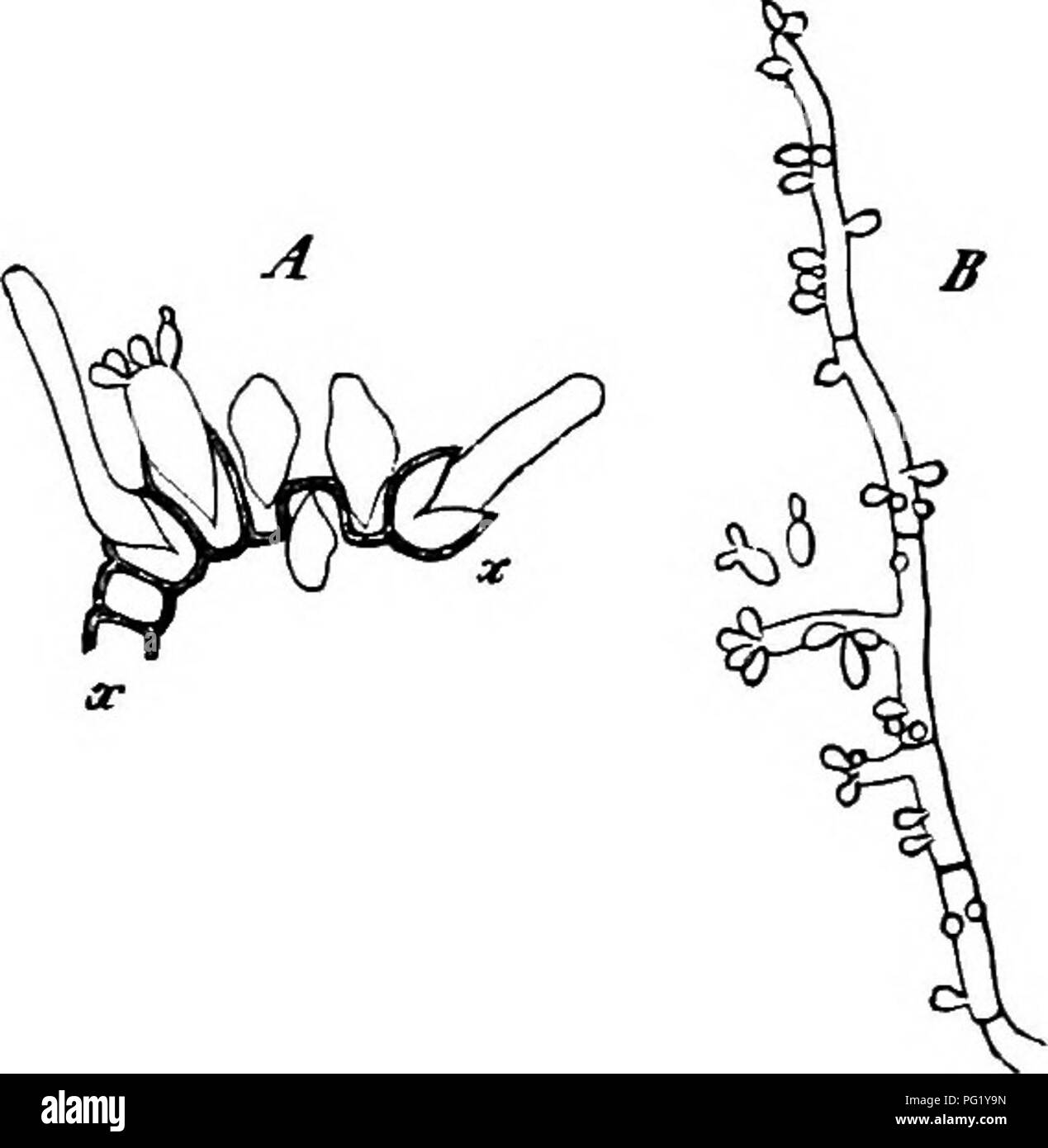 . Comparative morphology and biology of the fungi, mycetozoa and bacteria . Plant morphology; Fungi; Myxomycetes; Bacteriology. CHAPTER v.—COMPARATIVE REVIEW.—DOUBTFUL ASCOMYCETES. 271 opinion. They have shown that the earlier observers obtained uncertain results from having different and imperfectly distinguished forms mixed up together in their impure cultures, and have revealed another source of obscurity in their belief that every form of sprouting Fungus must be regarded as an inciter of fermentation or 'Yeast-fungus,' and conversely that all alcoholic fermentation was caused by the veget Stock Photohttps://www.alamy.com/image-license-details/?v=1https://www.alamy.com/comparative-morphology-and-biology-of-the-fungi-mycetozoa-and-bacteria-plant-morphology-fungi-myxomycetes-bacteriology-chapter-vcomparative-reviewdoubtful-ascomycetes-271-opinion-they-have-shown-that-the-earlier-observers-obtained-uncertain-results-from-having-different-and-imperfectly-distinguished-forms-mixed-up-together-in-their-impure-cultures-and-have-revealed-another-source-of-obscurity-in-their-belief-that-every-form-of-sprouting-fungus-must-be-regarded-as-an-inciter-of-fermentation-or-yeast-fungus-and-conversely-that-all-alcoholic-fermentation-was-caused-by-the-veget-image216402305.html
. Comparative morphology and biology of the fungi, mycetozoa and bacteria . Plant morphology; Fungi; Myxomycetes; Bacteriology. CHAPTER v.—COMPARATIVE REVIEW.—DOUBTFUL ASCOMYCETES. 271 opinion. They have shown that the earlier observers obtained uncertain results from having different and imperfectly distinguished forms mixed up together in their impure cultures, and have revealed another source of obscurity in their belief that every form of sprouting Fungus must be regarded as an inciter of fermentation or 'Yeast-fungus,' and conversely that all alcoholic fermentation was caused by the veget Stock Photohttps://www.alamy.com/image-license-details/?v=1https://www.alamy.com/comparative-morphology-and-biology-of-the-fungi-mycetozoa-and-bacteria-plant-morphology-fungi-myxomycetes-bacteriology-chapter-vcomparative-reviewdoubtful-ascomycetes-271-opinion-they-have-shown-that-the-earlier-observers-obtained-uncertain-results-from-having-different-and-imperfectly-distinguished-forms-mixed-up-together-in-their-impure-cultures-and-have-revealed-another-source-of-obscurity-in-their-belief-that-every-form-of-sprouting-fungus-must-be-regarded-as-an-inciter-of-fermentation-or-yeast-fungus-and-conversely-that-all-alcoholic-fermentation-was-caused-by-the-veget-image216402305.htmlRMPG1Y9N–. Comparative morphology and biology of the fungi, mycetozoa and bacteria . Plant morphology; Fungi; Myxomycetes; Bacteriology. CHAPTER v.—COMPARATIVE REVIEW.—DOUBTFUL ASCOMYCETES. 271 opinion. They have shown that the earlier observers obtained uncertain results from having different and imperfectly distinguished forms mixed up together in their impure cultures, and have revealed another source of obscurity in their belief that every form of sprouting Fungus must be regarded as an inciter of fermentation or 'Yeast-fungus,' and conversely that all alcoholic fermentation was caused by the veget
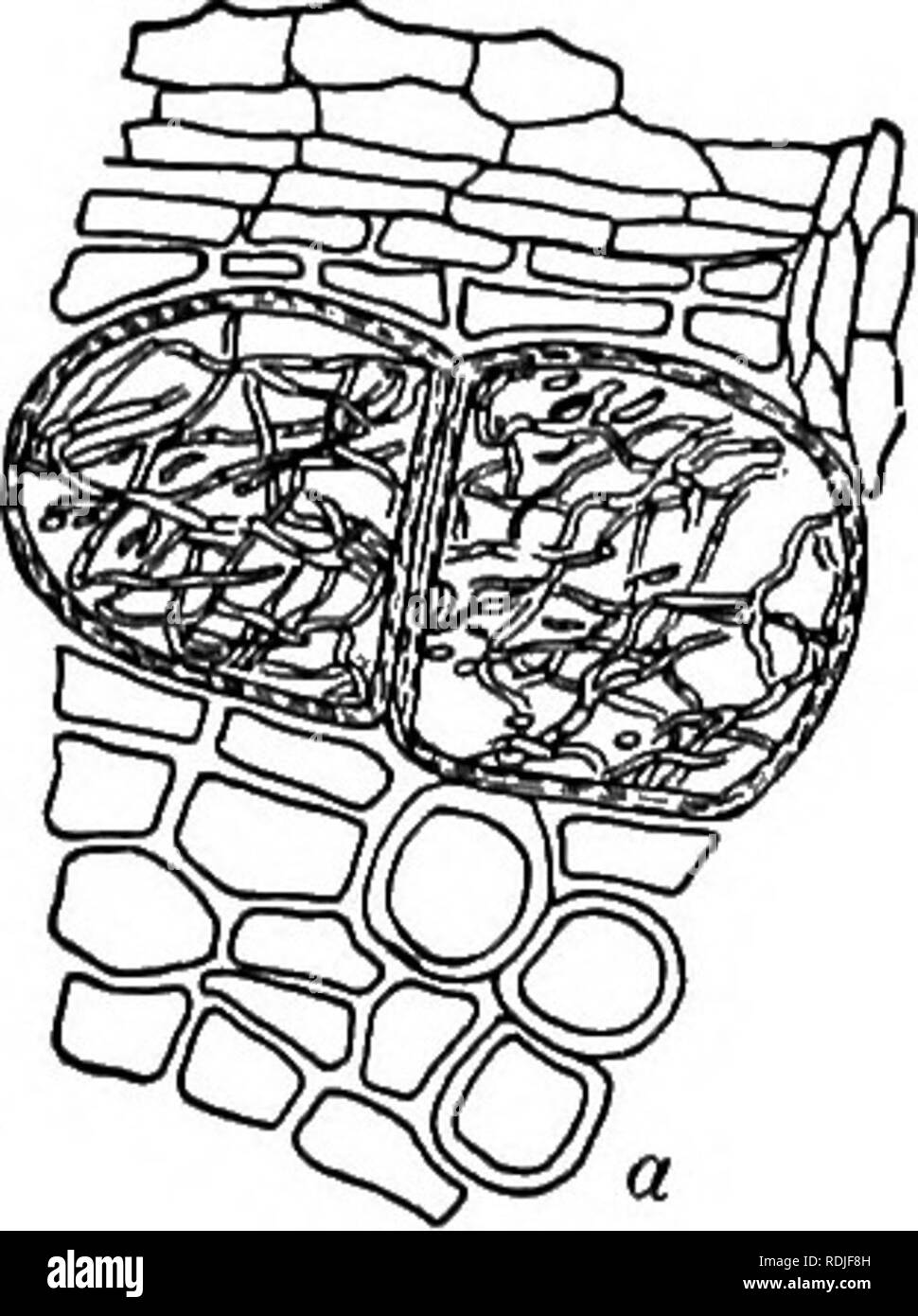 . Fungous diseases of plants : with chapters on physiology, culture methods and technique . Fungi in agriculture. ASCOMYCETES 237 In the same way as for the cotton, so also in the case of the cowpea, resistant races have been found. The most resistant of the original varieties tested was the form known as Iron Moun- tain, which has since been considerably crossed, and in various ways improved. The fungus. It has been stated that this fungus is unques- tionably very generally distributed and may live indefinitely in the soil. This is due to the fact that it is easily propagated in a saprophytic Stock Photohttps://www.alamy.com/image-license-details/?v=1https://www.alamy.com/fungous-diseases-of-plants-with-chapters-on-physiology-culture-methods-and-technique-fungi-in-agriculture-ascomycetes-237-in-the-same-way-as-for-the-cotton-so-also-in-the-case-of-the-cowpea-resistant-races-have-been-found-the-most-resistant-of-the-original-varieties-tested-was-the-form-known-as-iron-moun-tain-which-has-since-been-considerably-crossed-and-in-various-ways-improved-the-fungus-it-has-been-stated-that-this-fungus-is-unques-tionably-very-generally-distributed-and-may-live-indefinitely-in-the-soil-this-is-due-to-the-fact-that-it-is-easily-propagated-in-a-saprophytic-image232132449.html
. Fungous diseases of plants : with chapters on physiology, culture methods and technique . Fungi in agriculture. ASCOMYCETES 237 In the same way as for the cotton, so also in the case of the cowpea, resistant races have been found. The most resistant of the original varieties tested was the form known as Iron Moun- tain, which has since been considerably crossed, and in various ways improved. The fungus. It has been stated that this fungus is unques- tionably very generally distributed and may live indefinitely in the soil. This is due to the fact that it is easily propagated in a saprophytic Stock Photohttps://www.alamy.com/image-license-details/?v=1https://www.alamy.com/fungous-diseases-of-plants-with-chapters-on-physiology-culture-methods-and-technique-fungi-in-agriculture-ascomycetes-237-in-the-same-way-as-for-the-cotton-so-also-in-the-case-of-the-cowpea-resistant-races-have-been-found-the-most-resistant-of-the-original-varieties-tested-was-the-form-known-as-iron-moun-tain-which-has-since-been-considerably-crossed-and-in-various-ways-improved-the-fungus-it-has-been-stated-that-this-fungus-is-unques-tionably-very-generally-distributed-and-may-live-indefinitely-in-the-soil-this-is-due-to-the-fact-that-it-is-easily-propagated-in-a-saprophytic-image232132449.htmlRMRDJF8H–. Fungous diseases of plants : with chapters on physiology, culture methods and technique . Fungi in agriculture. ASCOMYCETES 237 In the same way as for the cotton, so also in the case of the cowpea, resistant races have been found. The most resistant of the original varieties tested was the form known as Iron Moun- tain, which has since been considerably crossed, and in various ways improved. The fungus. It has been stated that this fungus is unques- tionably very generally distributed and may live indefinitely in the soil. This is due to the fact that it is easily propagated in a saprophytic
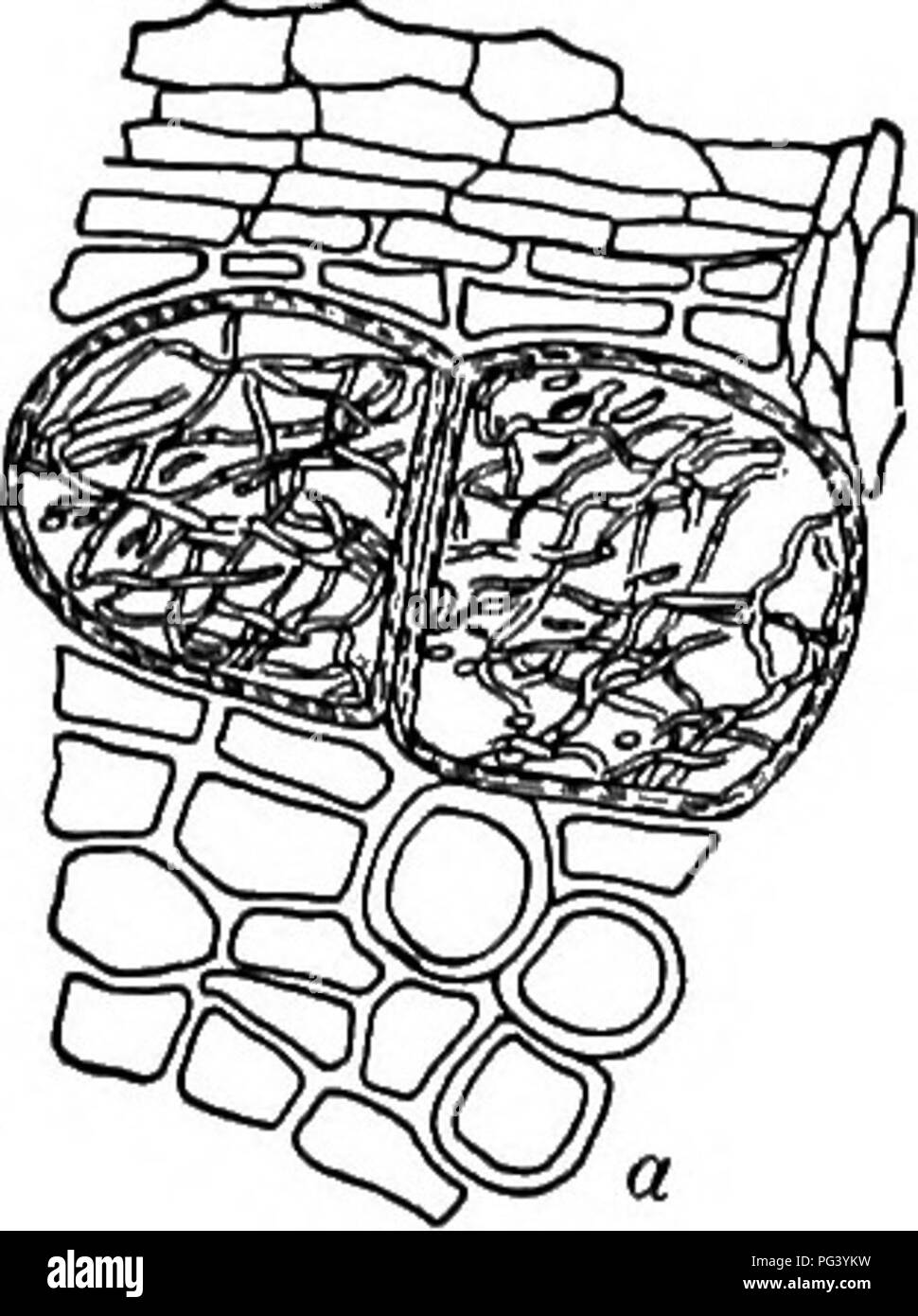 . Fungous diseases of plants : with chapters on physiology, culture methods and technique . Fungi in agriculture. ASCOMYCETES 237 In the same way as for the cotton, so also in the case of the cowpea, resistant races have been found. The most resistant of the original varieties tested was the form known as Iron Moun- tain, which has since been considerably crossed, and in various ways improved. The fungus. It has been stated that this fungus is unques- tionably very generally distributed and may live indefinitely in the soil. This is due to the fact that it is easily propagated in a saprophytic Stock Photohttps://www.alamy.com/image-license-details/?v=1https://www.alamy.com/fungous-diseases-of-plants-with-chapters-on-physiology-culture-methods-and-technique-fungi-in-agriculture-ascomycetes-237-in-the-same-way-as-for-the-cotton-so-also-in-the-case-of-the-cowpea-resistant-races-have-been-found-the-most-resistant-of-the-original-varieties-tested-was-the-form-known-as-iron-moun-tain-which-has-since-been-considerably-crossed-and-in-various-ways-improved-the-fungus-it-has-been-stated-that-this-fungus-is-unques-tionably-very-generally-distributed-and-may-live-indefinitely-in-the-soil-this-is-due-to-the-fact-that-it-is-easily-propagated-in-a-saprophytic-image216446493.html
. Fungous diseases of plants : with chapters on physiology, culture methods and technique . Fungi in agriculture. ASCOMYCETES 237 In the same way as for the cotton, so also in the case of the cowpea, resistant races have been found. The most resistant of the original varieties tested was the form known as Iron Moun- tain, which has since been considerably crossed, and in various ways improved. The fungus. It has been stated that this fungus is unques- tionably very generally distributed and may live indefinitely in the soil. This is due to the fact that it is easily propagated in a saprophytic Stock Photohttps://www.alamy.com/image-license-details/?v=1https://www.alamy.com/fungous-diseases-of-plants-with-chapters-on-physiology-culture-methods-and-technique-fungi-in-agriculture-ascomycetes-237-in-the-same-way-as-for-the-cotton-so-also-in-the-case-of-the-cowpea-resistant-races-have-been-found-the-most-resistant-of-the-original-varieties-tested-was-the-form-known-as-iron-moun-tain-which-has-since-been-considerably-crossed-and-in-various-ways-improved-the-fungus-it-has-been-stated-that-this-fungus-is-unques-tionably-very-generally-distributed-and-may-live-indefinitely-in-the-soil-this-is-due-to-the-fact-that-it-is-easily-propagated-in-a-saprophytic-image216446493.htmlRMPG3YKW–. Fungous diseases of plants : with chapters on physiology, culture methods and technique . Fungi in agriculture. ASCOMYCETES 237 In the same way as for the cotton, so also in the case of the cowpea, resistant races have been found. The most resistant of the original varieties tested was the form known as Iron Moun- tain, which has since been considerably crossed, and in various ways improved. The fungus. It has been stated that this fungus is unques- tionably very generally distributed and may live indefinitely in the soil. This is due to the fact that it is easily propagated in a saprophytic
 . Comparative morphology and biology of the fungi, mycetozoa and bacteria . Plant morphology; Fungi; Myxomycetes; Bacteriology. CHAPTER v.—COMPARATIVE REVIEW.—DOUBTFUL ASCOMYCETES. 271 opinion. They have shown that the earlier observers obtained uncertain results from having different and imperfectly distinguished forms mixed up together in their impure cultures, and have revealed another source of obscurity in their belief that every form of sprouting Fungus must be regarded as an inciter of fermentation or 'Yeast-fungus,' and conversely that all alcoholic fermentation was caused by the veget Stock Photohttps://www.alamy.com/image-license-details/?v=1https://www.alamy.com/comparative-morphology-and-biology-of-the-fungi-mycetozoa-and-bacteria-plant-morphology-fungi-myxomycetes-bacteriology-chapter-vcomparative-reviewdoubtful-ascomycetes-271-opinion-they-have-shown-that-the-earlier-observers-obtained-uncertain-results-from-having-different-and-imperfectly-distinguished-forms-mixed-up-together-in-their-impure-cultures-and-have-revealed-another-source-of-obscurity-in-their-belief-that-every-form-of-sprouting-fungus-must-be-regarded-as-an-inciter-of-fermentation-or-yeast-fungus-and-conversely-that-all-alcoholic-fermentation-was-caused-by-the-veget-image232040836.html
. Comparative morphology and biology of the fungi, mycetozoa and bacteria . Plant morphology; Fungi; Myxomycetes; Bacteriology. CHAPTER v.—COMPARATIVE REVIEW.—DOUBTFUL ASCOMYCETES. 271 opinion. They have shown that the earlier observers obtained uncertain results from having different and imperfectly distinguished forms mixed up together in their impure cultures, and have revealed another source of obscurity in their belief that every form of sprouting Fungus must be regarded as an inciter of fermentation or 'Yeast-fungus,' and conversely that all alcoholic fermentation was caused by the veget Stock Photohttps://www.alamy.com/image-license-details/?v=1https://www.alamy.com/comparative-morphology-and-biology-of-the-fungi-mycetozoa-and-bacteria-plant-morphology-fungi-myxomycetes-bacteriology-chapter-vcomparative-reviewdoubtful-ascomycetes-271-opinion-they-have-shown-that-the-earlier-observers-obtained-uncertain-results-from-having-different-and-imperfectly-distinguished-forms-mixed-up-together-in-their-impure-cultures-and-have-revealed-another-source-of-obscurity-in-their-belief-that-every-form-of-sprouting-fungus-must-be-regarded-as-an-inciter-of-fermentation-or-yeast-fungus-and-conversely-that-all-alcoholic-fermentation-was-caused-by-the-veget-image232040836.htmlRMRDEACM–. Comparative morphology and biology of the fungi, mycetozoa and bacteria . Plant morphology; Fungi; Myxomycetes; Bacteriology. CHAPTER v.—COMPARATIVE REVIEW.—DOUBTFUL ASCOMYCETES. 271 opinion. They have shown that the earlier observers obtained uncertain results from having different and imperfectly distinguished forms mixed up together in their impure cultures, and have revealed another source of obscurity in their belief that every form of sprouting Fungus must be regarded as an inciter of fermentation or 'Yeast-fungus,' and conversely that all alcoholic fermentation was caused by the veget
 . Fungous diseases of plants : with chapters on physiology, culture methods and technique . Fungi in agriculture. ASCOMYCETES 205 Distribution and occurrence. This anthracnose is a disease well known in Europe and America. Periodically since 1884 it has been mentioned as a destructive fungus to both white and red currants in New York. The fungus has also been found upon black currants and goose- berries, but it has never, apparently, amounted to an epidemic. Among red cur- rants Stewart observed that Prince Albert and President Wilder were practically free from injury where Fay's Prolific and Stock Photohttps://www.alamy.com/image-license-details/?v=1https://www.alamy.com/fungous-diseases-of-plants-with-chapters-on-physiology-culture-methods-and-technique-fungi-in-agriculture-ascomycetes-205-distribution-and-occurrence-this-anthracnose-is-a-disease-well-known-in-europe-and-america-periodically-since-1884-it-has-been-mentioned-as-a-destructive-fungus-to-both-white-and-red-currants-in-new-york-the-fungus-has-also-been-found-upon-black-currants-and-goose-berries-but-it-has-never-apparently-amounted-to-an-epidemic-among-red-cur-rants-stewart-observed-that-prince-albert-and-president-wilder-were-practically-free-from-injury-where-fays-prolific-and-image216446599.html
. Fungous diseases of plants : with chapters on physiology, culture methods and technique . Fungi in agriculture. ASCOMYCETES 205 Distribution and occurrence. This anthracnose is a disease well known in Europe and America. Periodically since 1884 it has been mentioned as a destructive fungus to both white and red currants in New York. The fungus has also been found upon black currants and goose- berries, but it has never, apparently, amounted to an epidemic. Among red cur- rants Stewart observed that Prince Albert and President Wilder were practically free from injury where Fay's Prolific and Stock Photohttps://www.alamy.com/image-license-details/?v=1https://www.alamy.com/fungous-diseases-of-plants-with-chapters-on-physiology-culture-methods-and-technique-fungi-in-agriculture-ascomycetes-205-distribution-and-occurrence-this-anthracnose-is-a-disease-well-known-in-europe-and-america-periodically-since-1884-it-has-been-mentioned-as-a-destructive-fungus-to-both-white-and-red-currants-in-new-york-the-fungus-has-also-been-found-upon-black-currants-and-goose-berries-but-it-has-never-apparently-amounted-to-an-epidemic-among-red-cur-rants-stewart-observed-that-prince-albert-and-president-wilder-were-practically-free-from-injury-where-fays-prolific-and-image216446599.htmlRMPG3YRK–. Fungous diseases of plants : with chapters on physiology, culture methods and technique . Fungi in agriculture. ASCOMYCETES 205 Distribution and occurrence. This anthracnose is a disease well known in Europe and America. Periodically since 1884 it has been mentioned as a destructive fungus to both white and red currants in New York. The fungus has also been found upon black currants and goose- berries, but it has never, apparently, amounted to an epidemic. Among red cur- rants Stewart observed that Prince Albert and President Wilder were practically free from injury where Fay's Prolific and
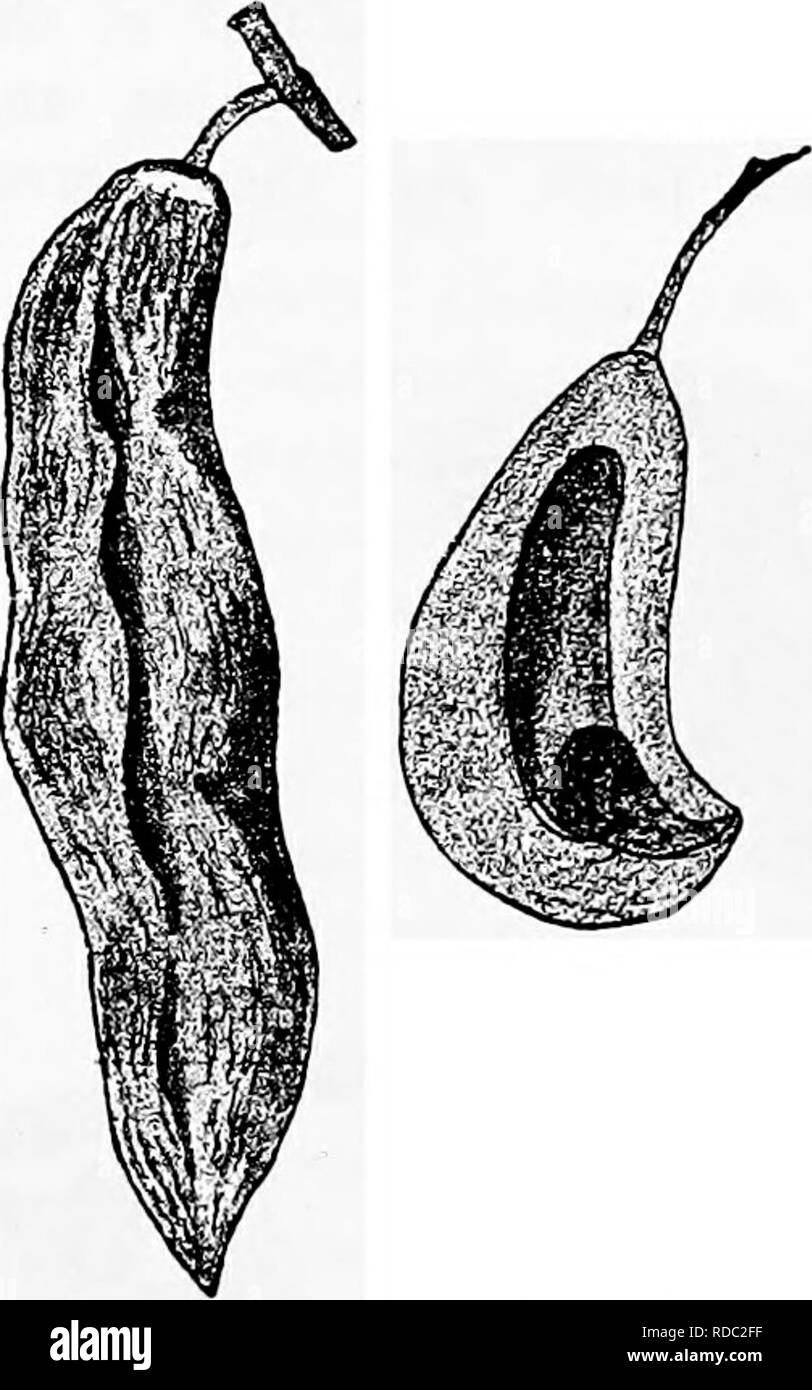 . Diseases of plants induced by cryptogamic parasites : introduction to the study of pathogenic Fungi, slime-Fungi, bacteria, & Algae . Plant diseases; Parasitic plants; Fungi. 156 ASCOMYCETES. Exoascus Rostrupianus Sad. This fungus causes " pockets " on Prunus spinosa (sloe) similar to the preceding species. According to Sadebeck, the asci in this case are more slender.. Please note that these images are extracted from scanned page images that may have been digitally enhanced for readability - coloration and appearance of these illustrations may not perfectly resemble the origin Stock Photohttps://www.alamy.com/image-license-details/?v=1https://www.alamy.com/diseases-of-plants-induced-by-cryptogamic-parasites-introduction-to-the-study-of-pathogenic-fungi-slime-fungi-bacteria-amp-algae-plant-diseases-parasitic-plants-fungi-156-ascomycetes-exoascus-rostrupianus-sad-this-fungus-causes-quot-pockets-quot-on-prunus-spinosa-sloe-similar-to-the-preceding-species-according-to-sadebeck-the-asci-in-this-case-are-more-slender-please-note-that-these-images-are-extracted-from-scanned-page-images-that-may-have-been-digitally-enhanced-for-readability-coloration-and-appearance-of-these-illustrations-may-not-perfectly-resemble-the-origin-image231990739.html
. Diseases of plants induced by cryptogamic parasites : introduction to the study of pathogenic Fungi, slime-Fungi, bacteria, & Algae . Plant diseases; Parasitic plants; Fungi. 156 ASCOMYCETES. Exoascus Rostrupianus Sad. This fungus causes " pockets " on Prunus spinosa (sloe) similar to the preceding species. According to Sadebeck, the asci in this case are more slender.. Please note that these images are extracted from scanned page images that may have been digitally enhanced for readability - coloration and appearance of these illustrations may not perfectly resemble the origin Stock Photohttps://www.alamy.com/image-license-details/?v=1https://www.alamy.com/diseases-of-plants-induced-by-cryptogamic-parasites-introduction-to-the-study-of-pathogenic-fungi-slime-fungi-bacteria-amp-algae-plant-diseases-parasitic-plants-fungi-156-ascomycetes-exoascus-rostrupianus-sad-this-fungus-causes-quot-pockets-quot-on-prunus-spinosa-sloe-similar-to-the-preceding-species-according-to-sadebeck-the-asci-in-this-case-are-more-slender-please-note-that-these-images-are-extracted-from-scanned-page-images-that-may-have-been-digitally-enhanced-for-readability-coloration-and-appearance-of-these-illustrations-may-not-perfectly-resemble-the-origin-image231990739.htmlRMRDC2FF–. Diseases of plants induced by cryptogamic parasites : introduction to the study of pathogenic Fungi, slime-Fungi, bacteria, & Algae . Plant diseases; Parasitic plants; Fungi. 156 ASCOMYCETES. Exoascus Rostrupianus Sad. This fungus causes " pockets " on Prunus spinosa (sloe) similar to the preceding species. According to Sadebeck, the asci in this case are more slender.. Please note that these images are extracted from scanned page images that may have been digitally enhanced for readability - coloration and appearance of these illustrations may not perfectly resemble the origin
 . Fungous diseases of plants : with chapters on physiology, culture methods and technique . Fungi in agriculture. ASCOMYCETES 235 the heavy soils of central Alabama were somewhat peculiarly affected by this fungus. There is first a yellowing and finally- a drying out of those portions of the leaves farthest from the main fibrovascular bundles, that is, between the lobes. Later such leaves might fall, or the whole plant might become wilted, and finally brown and dead. In other regions of the country the "wilting" is much more a characteristic appearance, — the dis- ease being scarcely Stock Photohttps://www.alamy.com/image-license-details/?v=1https://www.alamy.com/fungous-diseases-of-plants-with-chapters-on-physiology-culture-methods-and-technique-fungi-in-agriculture-ascomycetes-235-the-heavy-soils-of-central-alabama-were-somewhat-peculiarly-affected-by-this-fungus-there-is-first-a-yellowing-and-finally-a-drying-out-of-those-portions-of-the-leaves-farthest-from-the-main-fibrovascular-bundles-that-is-between-the-lobes-later-such-leaves-might-fall-or-the-whole-plant-might-become-wilted-and-finally-brown-and-dead-in-other-regions-of-the-country-the-quotwiltingquot-is-much-more-a-characteristic-appearance-the-dis-ease-being-scarcely-image216446499.html
. Fungous diseases of plants : with chapters on physiology, culture methods and technique . Fungi in agriculture. ASCOMYCETES 235 the heavy soils of central Alabama were somewhat peculiarly affected by this fungus. There is first a yellowing and finally- a drying out of those portions of the leaves farthest from the main fibrovascular bundles, that is, between the lobes. Later such leaves might fall, or the whole plant might become wilted, and finally brown and dead. In other regions of the country the "wilting" is much more a characteristic appearance, — the dis- ease being scarcely Stock Photohttps://www.alamy.com/image-license-details/?v=1https://www.alamy.com/fungous-diseases-of-plants-with-chapters-on-physiology-culture-methods-and-technique-fungi-in-agriculture-ascomycetes-235-the-heavy-soils-of-central-alabama-were-somewhat-peculiarly-affected-by-this-fungus-there-is-first-a-yellowing-and-finally-a-drying-out-of-those-portions-of-the-leaves-farthest-from-the-main-fibrovascular-bundles-that-is-between-the-lobes-later-such-leaves-might-fall-or-the-whole-plant-might-become-wilted-and-finally-brown-and-dead-in-other-regions-of-the-country-the-quotwiltingquot-is-much-more-a-characteristic-appearance-the-dis-ease-being-scarcely-image216446499.htmlRMPG3YM3–. Fungous diseases of plants : with chapters on physiology, culture methods and technique . Fungi in agriculture. ASCOMYCETES 235 the heavy soils of central Alabama were somewhat peculiarly affected by this fungus. There is first a yellowing and finally- a drying out of those portions of the leaves farthest from the main fibrovascular bundles, that is, between the lobes. Later such leaves might fall, or the whole plant might become wilted, and finally brown and dead. In other regions of the country the "wilting" is much more a characteristic appearance, — the dis- ease being scarcely
 . Fungous diseases of plants : with chapters on physiology, culture methods and technique . Fungi in agriculture. ASCOMYCETES 179 the new growth. It was formerly supposed that this fungus was very largely propagated by a perennating mycelium, or by infec- tions resulting during the summer and persisting in the woody parts until the following season, but as will be shown later, infec- tions must generally occur as the buds unfold. The percentage resulting from a mycelium remaining alive in the hypertrophied twigs is very small. The badly affected twig dies and the my- celium with it. From other Stock Photohttps://www.alamy.com/image-license-details/?v=1https://www.alamy.com/fungous-diseases-of-plants-with-chapters-on-physiology-culture-methods-and-technique-fungi-in-agriculture-ascomycetes-179-the-new-growth-it-was-formerly-supposed-that-this-fungus-was-very-largely-propagated-by-a-perennating-mycelium-or-by-infec-tions-resulting-during-the-summer-and-persisting-in-the-woody-parts-until-the-following-season-but-as-will-be-shown-later-infec-tions-must-generally-occur-as-the-buds-unfold-the-percentage-resulting-from-a-mycelium-remaining-alive-in-the-hypertrophied-twigs-is-very-small-the-badly-affected-twig-dies-and-the-my-celium-with-it-from-other-image232132667.html
. Fungous diseases of plants : with chapters on physiology, culture methods and technique . Fungi in agriculture. ASCOMYCETES 179 the new growth. It was formerly supposed that this fungus was very largely propagated by a perennating mycelium, or by infec- tions resulting during the summer and persisting in the woody parts until the following season, but as will be shown later, infec- tions must generally occur as the buds unfold. The percentage resulting from a mycelium remaining alive in the hypertrophied twigs is very small. The badly affected twig dies and the my- celium with it. From other Stock Photohttps://www.alamy.com/image-license-details/?v=1https://www.alamy.com/fungous-diseases-of-plants-with-chapters-on-physiology-culture-methods-and-technique-fungi-in-agriculture-ascomycetes-179-the-new-growth-it-was-formerly-supposed-that-this-fungus-was-very-largely-propagated-by-a-perennating-mycelium-or-by-infec-tions-resulting-during-the-summer-and-persisting-in-the-woody-parts-until-the-following-season-but-as-will-be-shown-later-infec-tions-must-generally-occur-as-the-buds-unfold-the-percentage-resulting-from-a-mycelium-remaining-alive-in-the-hypertrophied-twigs-is-very-small-the-badly-affected-twig-dies-and-the-my-celium-with-it-from-other-image232132667.htmlRMRDJFGB–. Fungous diseases of plants : with chapters on physiology, culture methods and technique . Fungi in agriculture. ASCOMYCETES 179 the new growth. It was formerly supposed that this fungus was very largely propagated by a perennating mycelium, or by infec- tions resulting during the summer and persisting in the woody parts until the following season, but as will be shown later, infec- tions must generally occur as the buds unfold. The percentage resulting from a mycelium remaining alive in the hypertrophied twigs is very small. The badly affected twig dies and the my- celium with it. From other
 . Fungous diseases of plants : with chapters on physiology, culture methods and technique . Fungi in agriculture. ASCOMYCETES 273 Illinois amounting to $1,500,000. Apple growers have become so thoroughly informed as to the destruction of this disease that they have to a large extent adopted the remedies recommended as a result of recent investigations, and steps are now very generally taken to control this fungus. This general interest which has been awakened will doubtless tend to diminish losses in future years. Parts of the plant affected. Upon the apple the bitter rot fungus is active chie Stock Photohttps://www.alamy.com/image-license-details/?v=1https://www.alamy.com/fungous-diseases-of-plants-with-chapters-on-physiology-culture-methods-and-technique-fungi-in-agriculture-ascomycetes-273-illinois-amounting-to-1500000-apple-growers-have-become-so-thoroughly-informed-as-to-the-destruction-of-this-disease-that-they-have-to-a-large-extent-adopted-the-remedies-recommended-as-a-result-of-recent-investigations-and-steps-are-now-very-generally-taken-to-control-this-fungus-this-general-interest-which-has-been-awakened-will-doubtless-tend-to-diminish-losses-in-future-years-parts-of-the-plant-affected-upon-the-apple-the-bitter-rot-fungus-is-active-chie-image216446383.html
. Fungous diseases of plants : with chapters on physiology, culture methods and technique . Fungi in agriculture. ASCOMYCETES 273 Illinois amounting to $1,500,000. Apple growers have become so thoroughly informed as to the destruction of this disease that they have to a large extent adopted the remedies recommended as a result of recent investigations, and steps are now very generally taken to control this fungus. This general interest which has been awakened will doubtless tend to diminish losses in future years. Parts of the plant affected. Upon the apple the bitter rot fungus is active chie Stock Photohttps://www.alamy.com/image-license-details/?v=1https://www.alamy.com/fungous-diseases-of-plants-with-chapters-on-physiology-culture-methods-and-technique-fungi-in-agriculture-ascomycetes-273-illinois-amounting-to-1500000-apple-growers-have-become-so-thoroughly-informed-as-to-the-destruction-of-this-disease-that-they-have-to-a-large-extent-adopted-the-remedies-recommended-as-a-result-of-recent-investigations-and-steps-are-now-very-generally-taken-to-control-this-fungus-this-general-interest-which-has-been-awakened-will-doubtless-tend-to-diminish-losses-in-future-years-parts-of-the-plant-affected-upon-the-apple-the-bitter-rot-fungus-is-active-chie-image216446383.htmlRMPG3YFY–. Fungous diseases of plants : with chapters on physiology, culture methods and technique . Fungi in agriculture. ASCOMYCETES 273 Illinois amounting to $1,500,000. Apple growers have become so thoroughly informed as to the destruction of this disease that they have to a large extent adopted the remedies recommended as a result of recent investigations, and steps are now very generally taken to control this fungus. This general interest which has been awakened will doubtless tend to diminish losses in future years. Parts of the plant affected. Upon the apple the bitter rot fungus is active chie
 . Fungous diseases of plants : with chapters on physiology, culture methods and technique . Fungi in agriculture. ASCOMYCETES 205 Distribution and occurrence. This anthracnose is a disease well known in Europe and America. Periodically since 1884 it has been mentioned as a destructive fungus to both white and red currants in New York. The fungus has also been found upon black currants and goose- berries, but it has never, apparently, amounted to an epidemic. Among red cur- rants Stewart observed that Prince Albert and President Wilder were practically free from injury where Fay's Prolific and Stock Photohttps://www.alamy.com/image-license-details/?v=1https://www.alamy.com/fungous-diseases-of-plants-with-chapters-on-physiology-culture-methods-and-technique-fungi-in-agriculture-ascomycetes-205-distribution-and-occurrence-this-anthracnose-is-a-disease-well-known-in-europe-and-america-periodically-since-1884-it-has-been-mentioned-as-a-destructive-fungus-to-both-white-and-red-currants-in-new-york-the-fungus-has-also-been-found-upon-black-currants-and-goose-berries-but-it-has-never-apparently-amounted-to-an-epidemic-among-red-cur-rants-stewart-observed-that-prince-albert-and-president-wilder-were-practically-free-from-injury-where-fays-prolific-and-image232132580.html
. Fungous diseases of plants : with chapters on physiology, culture methods and technique . Fungi in agriculture. ASCOMYCETES 205 Distribution and occurrence. This anthracnose is a disease well known in Europe and America. Periodically since 1884 it has been mentioned as a destructive fungus to both white and red currants in New York. The fungus has also been found upon black currants and goose- berries, but it has never, apparently, amounted to an epidemic. Among red cur- rants Stewart observed that Prince Albert and President Wilder were practically free from injury where Fay's Prolific and Stock Photohttps://www.alamy.com/image-license-details/?v=1https://www.alamy.com/fungous-diseases-of-plants-with-chapters-on-physiology-culture-methods-and-technique-fungi-in-agriculture-ascomycetes-205-distribution-and-occurrence-this-anthracnose-is-a-disease-well-known-in-europe-and-america-periodically-since-1884-it-has-been-mentioned-as-a-destructive-fungus-to-both-white-and-red-currants-in-new-york-the-fungus-has-also-been-found-upon-black-currants-and-goose-berries-but-it-has-never-apparently-amounted-to-an-epidemic-among-red-cur-rants-stewart-observed-that-prince-albert-and-president-wilder-were-practically-free-from-injury-where-fays-prolific-and-image232132580.htmlRMRDJFD8–. Fungous diseases of plants : with chapters on physiology, culture methods and technique . Fungi in agriculture. ASCOMYCETES 205 Distribution and occurrence. This anthracnose is a disease well known in Europe and America. Periodically since 1884 it has been mentioned as a destructive fungus to both white and red currants in New York. The fungus has also been found upon black currants and goose- berries, but it has never, apparently, amounted to an epidemic. Among red cur- rants Stewart observed that Prince Albert and President Wilder were practically free from injury where Fay's Prolific and
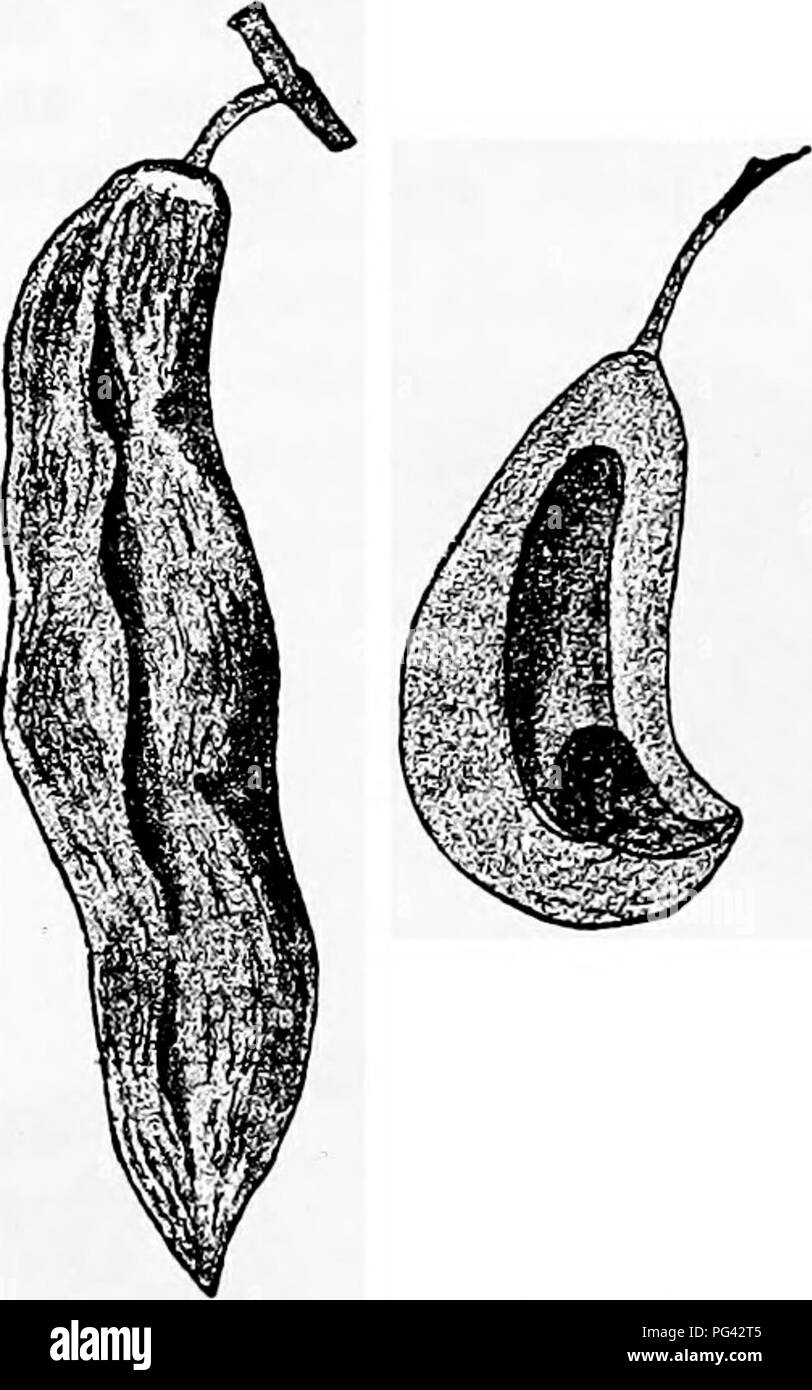 . Diseases of plants induced by cryptogamic parasites : introduction to the study of pathogenic Fungi, slime-Fungi, bacteria, & Algae . Plant diseases; Parasitic plants; Fungi. 156 ASCOMYCETES. Exoascus Rostrupianus Sad. This fungus causes " pockets " on Prunus spinosa (sloe) similar to the preceding species. According to Sadebeck, the asci in this case are more slender.. Please note that these images are extracted from scanned page images that may have been digitally enhanced for readability - coloration and appearance of these illustrations may not perfectly resemble the origin Stock Photohttps://www.alamy.com/image-license-details/?v=1https://www.alamy.com/diseases-of-plants-induced-by-cryptogamic-parasites-introduction-to-the-study-of-pathogenic-fungi-slime-fungi-bacteria-amp-algae-plant-diseases-parasitic-plants-fungi-156-ascomycetes-exoascus-rostrupianus-sad-this-fungus-causes-quot-pockets-quot-on-prunus-spinosa-sloe-similar-to-the-preceding-species-according-to-sadebeck-the-asci-in-this-case-are-more-slender-please-note-that-these-images-are-extracted-from-scanned-page-images-that-may-have-been-digitally-enhanced-for-readability-coloration-and-appearance-of-these-illustrations-may-not-perfectly-resemble-the-origin-image216448965.html
. Diseases of plants induced by cryptogamic parasites : introduction to the study of pathogenic Fungi, slime-Fungi, bacteria, & Algae . Plant diseases; Parasitic plants; Fungi. 156 ASCOMYCETES. Exoascus Rostrupianus Sad. This fungus causes " pockets " on Prunus spinosa (sloe) similar to the preceding species. According to Sadebeck, the asci in this case are more slender.. Please note that these images are extracted from scanned page images that may have been digitally enhanced for readability - coloration and appearance of these illustrations may not perfectly resemble the origin Stock Photohttps://www.alamy.com/image-license-details/?v=1https://www.alamy.com/diseases-of-plants-induced-by-cryptogamic-parasites-introduction-to-the-study-of-pathogenic-fungi-slime-fungi-bacteria-amp-algae-plant-diseases-parasitic-plants-fungi-156-ascomycetes-exoascus-rostrupianus-sad-this-fungus-causes-quot-pockets-quot-on-prunus-spinosa-sloe-similar-to-the-preceding-species-according-to-sadebeck-the-asci-in-this-case-are-more-slender-please-note-that-these-images-are-extracted-from-scanned-page-images-that-may-have-been-digitally-enhanced-for-readability-coloration-and-appearance-of-these-illustrations-may-not-perfectly-resemble-the-origin-image216448965.htmlRMPG42T5–. Diseases of plants induced by cryptogamic parasites : introduction to the study of pathogenic Fungi, slime-Fungi, bacteria, & Algae . Plant diseases; Parasitic plants; Fungi. 156 ASCOMYCETES. Exoascus Rostrupianus Sad. This fungus causes " pockets " on Prunus spinosa (sloe) similar to the preceding species. According to Sadebeck, the asci in this case are more slender.. Please note that these images are extracted from scanned page images that may have been digitally enhanced for readability - coloration and appearance of these illustrations may not perfectly resemble the origin
 . Fungous diseases of plants : with chapters on physiology, culture methods and technique . Fungi in agriculture. ASCOMYCETES 255 Distribution. The most serious menace to grape growing in most sections of the United States is the well-known black rot, a fungus of American origin, the effects of which have been known for considerably more than half a century. The black rot is now very generally distributed throughout the grape-growing sections of the United States and is reckoned with as a constant foe wherever susceptible varieties are grown. It is supposed to have been introduced into France Stock Photohttps://www.alamy.com/image-license-details/?v=1https://www.alamy.com/fungous-diseases-of-plants-with-chapters-on-physiology-culture-methods-and-technique-fungi-in-agriculture-ascomycetes-255-distribution-the-most-serious-menace-to-grape-growing-in-most-sections-of-the-united-states-is-the-well-known-black-rot-a-fungus-of-american-origin-the-effects-of-which-have-been-known-for-considerably-more-than-half-a-century-the-black-rot-is-now-very-generally-distributed-throughout-the-grape-growing-sections-of-the-united-states-and-is-reckoned-with-as-a-constant-foe-wherever-susceptible-varieties-are-grown-it-is-supposed-to-have-been-introduced-into-france-image232132383.html
. Fungous diseases of plants : with chapters on physiology, culture methods and technique . Fungi in agriculture. ASCOMYCETES 255 Distribution. The most serious menace to grape growing in most sections of the United States is the well-known black rot, a fungus of American origin, the effects of which have been known for considerably more than half a century. The black rot is now very generally distributed throughout the grape-growing sections of the United States and is reckoned with as a constant foe wherever susceptible varieties are grown. It is supposed to have been introduced into France Stock Photohttps://www.alamy.com/image-license-details/?v=1https://www.alamy.com/fungous-diseases-of-plants-with-chapters-on-physiology-culture-methods-and-technique-fungi-in-agriculture-ascomycetes-255-distribution-the-most-serious-menace-to-grape-growing-in-most-sections-of-the-united-states-is-the-well-known-black-rot-a-fungus-of-american-origin-the-effects-of-which-have-been-known-for-considerably-more-than-half-a-century-the-black-rot-is-now-very-generally-distributed-throughout-the-grape-growing-sections-of-the-united-states-and-is-reckoned-with-as-a-constant-foe-wherever-susceptible-varieties-are-grown-it-is-supposed-to-have-been-introduced-into-france-image232132383.htmlRMRDJF67–. Fungous diseases of plants : with chapters on physiology, culture methods and technique . Fungi in agriculture. ASCOMYCETES 255 Distribution. The most serious menace to grape growing in most sections of the United States is the well-known black rot, a fungus of American origin, the effects of which have been known for considerably more than half a century. The black rot is now very generally distributed throughout the grape-growing sections of the United States and is reckoned with as a constant foe wherever susceptible varieties are grown. It is supposed to have been introduced into France
 . Fungous diseases of plants : with chapters on physiology, culture methods and technique . Fungi in agriculture. ASCOMYCETES 283 destructive in that state. Under ordinary circumstances the fungus is doubtless a mere saprophyte, and it. is not restricted to the apple or to other members of the apple family. It has in fact been found upon such trees as the following: American elm (Ulmus america?ia), Magnolia sp., Judas tree (Cercis canadensis), and Sorbus sp. Symptoms. The disease is usually found upon the larger limbs or upon the trunk, and the appearance of the canker areas is so characterist Stock Photohttps://www.alamy.com/image-license-details/?v=1https://www.alamy.com/fungous-diseases-of-plants-with-chapters-on-physiology-culture-methods-and-technique-fungi-in-agriculture-ascomycetes-283-destructive-in-that-state-under-ordinary-circumstances-the-fungus-is-doubtless-a-mere-saprophyte-and-it-is-not-restricted-to-the-apple-or-to-other-members-of-the-apple-family-it-has-in-fact-been-found-upon-such-trees-as-the-following-american-elm-ulmus-americaia-magnolia-sp-judas-tree-cercis-canadensis-and-sorbus-sp-symptoms-the-disease-is-usually-found-upon-the-larger-limbs-or-upon-the-trunk-and-the-appearance-of-the-canker-areas-is-so-characterist-image216446373.html
. Fungous diseases of plants : with chapters on physiology, culture methods and technique . Fungi in agriculture. ASCOMYCETES 283 destructive in that state. Under ordinary circumstances the fungus is doubtless a mere saprophyte, and it. is not restricted to the apple or to other members of the apple family. It has in fact been found upon such trees as the following: American elm (Ulmus america?ia), Magnolia sp., Judas tree (Cercis canadensis), and Sorbus sp. Symptoms. The disease is usually found upon the larger limbs or upon the trunk, and the appearance of the canker areas is so characterist Stock Photohttps://www.alamy.com/image-license-details/?v=1https://www.alamy.com/fungous-diseases-of-plants-with-chapters-on-physiology-culture-methods-and-technique-fungi-in-agriculture-ascomycetes-283-destructive-in-that-state-under-ordinary-circumstances-the-fungus-is-doubtless-a-mere-saprophyte-and-it-is-not-restricted-to-the-apple-or-to-other-members-of-the-apple-family-it-has-in-fact-been-found-upon-such-trees-as-the-following-american-elm-ulmus-americaia-magnolia-sp-judas-tree-cercis-canadensis-and-sorbus-sp-symptoms-the-disease-is-usually-found-upon-the-larger-limbs-or-upon-the-trunk-and-the-appearance-of-the-canker-areas-is-so-characterist-image216446373.htmlRMPG3YFH–. Fungous diseases of plants : with chapters on physiology, culture methods and technique . Fungi in agriculture. ASCOMYCETES 283 destructive in that state. Under ordinary circumstances the fungus is doubtless a mere saprophyte, and it. is not restricted to the apple or to other members of the apple family. It has in fact been found upon such trees as the following: American elm (Ulmus america?ia), Magnolia sp., Judas tree (Cercis canadensis), and Sorbus sp. Symptoms. The disease is usually found upon the larger limbs or upon the trunk, and the appearance of the canker areas is so characterist
 . Fungous diseases of plants : with chapters on physiology, culture methods and technique . Fungi in agriculture. ASCOMYCETES 273 Illinois amounting to $1,500,000. Apple growers have become so thoroughly informed as to the destruction of this disease that they have to a large extent adopted the remedies recommended as a result of recent investigations, and steps are now very generally taken to control this fungus. This general interest which has been awakened will doubtless tend to diminish losses in future years. Parts of the plant affected. Upon the apple the bitter rot fungus is active chie Stock Photohttps://www.alamy.com/image-license-details/?v=1https://www.alamy.com/fungous-diseases-of-plants-with-chapters-on-physiology-culture-methods-and-technique-fungi-in-agriculture-ascomycetes-273-illinois-amounting-to-1500000-apple-growers-have-become-so-thoroughly-informed-as-to-the-destruction-of-this-disease-that-they-have-to-a-large-extent-adopted-the-remedies-recommended-as-a-result-of-recent-investigations-and-steps-are-now-very-generally-taken-to-control-this-fungus-this-general-interest-which-has-been-awakened-will-doubtless-tend-to-diminish-losses-in-future-years-parts-of-the-plant-affected-upon-the-apple-the-bitter-rot-fungus-is-active-chie-image232132309.html
. Fungous diseases of plants : with chapters on physiology, culture methods and technique . Fungi in agriculture. ASCOMYCETES 273 Illinois amounting to $1,500,000. Apple growers have become so thoroughly informed as to the destruction of this disease that they have to a large extent adopted the remedies recommended as a result of recent investigations, and steps are now very generally taken to control this fungus. This general interest which has been awakened will doubtless tend to diminish losses in future years. Parts of the plant affected. Upon the apple the bitter rot fungus is active chie Stock Photohttps://www.alamy.com/image-license-details/?v=1https://www.alamy.com/fungous-diseases-of-plants-with-chapters-on-physiology-culture-methods-and-technique-fungi-in-agriculture-ascomycetes-273-illinois-amounting-to-1500000-apple-growers-have-become-so-thoroughly-informed-as-to-the-destruction-of-this-disease-that-they-have-to-a-large-extent-adopted-the-remedies-recommended-as-a-result-of-recent-investigations-and-steps-are-now-very-generally-taken-to-control-this-fungus-this-general-interest-which-has-been-awakened-will-doubtless-tend-to-diminish-losses-in-future-years-parts-of-the-plant-affected-upon-the-apple-the-bitter-rot-fungus-is-active-chie-image232132309.htmlRMRDJF3H–. Fungous diseases of plants : with chapters on physiology, culture methods and technique . Fungi in agriculture. ASCOMYCETES 273 Illinois amounting to $1,500,000. Apple growers have become so thoroughly informed as to the destruction of this disease that they have to a large extent adopted the remedies recommended as a result of recent investigations, and steps are now very generally taken to control this fungus. This general interest which has been awakened will doubtless tend to diminish losses in future years. Parts of the plant affected. Upon the apple the bitter rot fungus is active chie
 . Fungous diseases of plants : with chapters on physiology, culture methods and technique . Fungi in agriculture. ASCOMYCETES 255 Distribution. The most serious menace to grape growing in most sections of the United States is the well-known black rot, a fungus of American origin, the effects of which have been known for considerably more than half a century. The black rot is now very generally distributed throughout the grape-growing sections of the United States and is reckoned with as a constant foe wherever susceptible varieties are grown. It is supposed to have been introduced into France Stock Photohttps://www.alamy.com/image-license-details/?v=1https://www.alamy.com/fungous-diseases-of-plants-with-chapters-on-physiology-culture-methods-and-technique-fungi-in-agriculture-ascomycetes-255-distribution-the-most-serious-menace-to-grape-growing-in-most-sections-of-the-united-states-is-the-well-known-black-rot-a-fungus-of-american-origin-the-effects-of-which-have-been-known-for-considerably-more-than-half-a-century-the-black-rot-is-now-very-generally-distributed-throughout-the-grape-growing-sections-of-the-united-states-and-is-reckoned-with-as-a-constant-foe-wherever-susceptible-varieties-are-grown-it-is-supposed-to-have-been-introduced-into-france-image216446435.html
. Fungous diseases of plants : with chapters on physiology, culture methods and technique . Fungi in agriculture. ASCOMYCETES 255 Distribution. The most serious menace to grape growing in most sections of the United States is the well-known black rot, a fungus of American origin, the effects of which have been known for considerably more than half a century. The black rot is now very generally distributed throughout the grape-growing sections of the United States and is reckoned with as a constant foe wherever susceptible varieties are grown. It is supposed to have been introduced into France Stock Photohttps://www.alamy.com/image-license-details/?v=1https://www.alamy.com/fungous-diseases-of-plants-with-chapters-on-physiology-culture-methods-and-technique-fungi-in-agriculture-ascomycetes-255-distribution-the-most-serious-menace-to-grape-growing-in-most-sections-of-the-united-states-is-the-well-known-black-rot-a-fungus-of-american-origin-the-effects-of-which-have-been-known-for-considerably-more-than-half-a-century-the-black-rot-is-now-very-generally-distributed-throughout-the-grape-growing-sections-of-the-united-states-and-is-reckoned-with-as-a-constant-foe-wherever-susceptible-varieties-are-grown-it-is-supposed-to-have-been-introduced-into-france-image216446435.htmlRMPG3YHR–. Fungous diseases of plants : with chapters on physiology, culture methods and technique . Fungi in agriculture. ASCOMYCETES 255 Distribution. The most serious menace to grape growing in most sections of the United States is the well-known black rot, a fungus of American origin, the effects of which have been known for considerably more than half a century. The black rot is now very generally distributed throughout the grape-growing sections of the United States and is reckoned with as a constant foe wherever susceptible varieties are grown. It is supposed to have been introduced into France
![. Fungi, ascomycetes, ustilaginales, uredinales. Fungi. n] ASCOMYCETES 39 (i-«-.. hymenium. In Desmotascus^, a pyrenomycetous fungus parasitic on Bromelia, the paraphyses are replaced by a thin-walled pseudoparenchyma recalling the arrangement in the higher Plectomycetes. The Peridium. The peridium or wall of the ascocarp is a weft of sterile hyphae in which the individual filamentsare sometimes clear- '^- ly distinguished, sometimes closely interwoven to form a pseudoparenchyma; the walls of the outer cells are some- times considerably thickened and may be variously pig- mented ; in many case Stock Photo . Fungi, ascomycetes, ustilaginales, uredinales. Fungi. n] ASCOMYCETES 39 (i-«-.. hymenium. In Desmotascus^, a pyrenomycetous fungus parasitic on Bromelia, the paraphyses are replaced by a thin-walled pseudoparenchyma recalling the arrangement in the higher Plectomycetes. The Peridium. The peridium or wall of the ascocarp is a weft of sterile hyphae in which the individual filamentsare sometimes clear- '^- ly distinguished, sometimes closely interwoven to form a pseudoparenchyma; the walls of the outer cells are some- times considerably thickened and may be variously pig- mented ; in many case Stock Photo](https://c8.alamy.com/comp/RDX1TR/fungi-ascomycetes-ustilaginales-uredinales-fungi-n-ascomycetes-39-i-hymenium-in-desmotascus-a-pyrenomycetous-fungus-parasitic-on-bromelia-the-paraphyses-are-replaced-by-a-thin-walled-pseudoparenchyma-recalling-the-arrangement-in-the-higher-plectomycetes-the-peridium-the-peridium-or-wall-of-the-ascocarp-is-a-weft-of-sterile-hyphae-in-which-the-individual-filamentsare-sometimes-clear-ly-distinguished-sometimes-closely-interwoven-to-form-a-pseudoparenchyma-the-walls-of-the-outer-cells-are-some-times-considerably-thickened-and-may-be-variously-pig-mented-in-many-case-RDX1TR.jpg) . Fungi, ascomycetes, ustilaginales, uredinales. Fungi. n] ASCOMYCETES 39 (i-«-.. hymenium. In Desmotascus^, a pyrenomycetous fungus parasitic on Bromelia, the paraphyses are replaced by a thin-walled pseudoparenchyma recalling the arrangement in the higher Plectomycetes. The Peridium. The peridium or wall of the ascocarp is a weft of sterile hyphae in which the individual filamentsare sometimes clear- '^- ly distinguished, sometimes closely interwoven to form a pseudoparenchyma; the walls of the outer cells are some- times considerably thickened and may be variously pig- mented ; in many case Stock Photohttps://www.alamy.com/image-license-details/?v=1https://www.alamy.com/fungi-ascomycetes-ustilaginales-uredinales-fungi-n-ascomycetes-39-i-hymenium-in-desmotascus-a-pyrenomycetous-fungus-parasitic-on-bromelia-the-paraphyses-are-replaced-by-a-thin-walled-pseudoparenchyma-recalling-the-arrangement-in-the-higher-plectomycetes-the-peridium-the-peridium-or-wall-of-the-ascocarp-is-a-weft-of-sterile-hyphae-in-which-the-individual-filamentsare-sometimes-clear-ly-distinguished-sometimes-closely-interwoven-to-form-a-pseudoparenchyma-the-walls-of-the-outer-cells-are-some-times-considerably-thickened-and-may-be-variously-pig-mented-in-many-case-image232297543.html
. Fungi, ascomycetes, ustilaginales, uredinales. Fungi. n] ASCOMYCETES 39 (i-«-.. hymenium. In Desmotascus^, a pyrenomycetous fungus parasitic on Bromelia, the paraphyses are replaced by a thin-walled pseudoparenchyma recalling the arrangement in the higher Plectomycetes. The Peridium. The peridium or wall of the ascocarp is a weft of sterile hyphae in which the individual filamentsare sometimes clear- '^- ly distinguished, sometimes closely interwoven to form a pseudoparenchyma; the walls of the outer cells are some- times considerably thickened and may be variously pig- mented ; in many case Stock Photohttps://www.alamy.com/image-license-details/?v=1https://www.alamy.com/fungi-ascomycetes-ustilaginales-uredinales-fungi-n-ascomycetes-39-i-hymenium-in-desmotascus-a-pyrenomycetous-fungus-parasitic-on-bromelia-the-paraphyses-are-replaced-by-a-thin-walled-pseudoparenchyma-recalling-the-arrangement-in-the-higher-plectomycetes-the-peridium-the-peridium-or-wall-of-the-ascocarp-is-a-weft-of-sterile-hyphae-in-which-the-individual-filamentsare-sometimes-clear-ly-distinguished-sometimes-closely-interwoven-to-form-a-pseudoparenchyma-the-walls-of-the-outer-cells-are-some-times-considerably-thickened-and-may-be-variously-pig-mented-in-many-case-image232297543.htmlRMRDX1TR–. Fungi, ascomycetes, ustilaginales, uredinales. Fungi. n] ASCOMYCETES 39 (i-«-.. hymenium. In Desmotascus^, a pyrenomycetous fungus parasitic on Bromelia, the paraphyses are replaced by a thin-walled pseudoparenchyma recalling the arrangement in the higher Plectomycetes. The Peridium. The peridium or wall of the ascocarp is a weft of sterile hyphae in which the individual filamentsare sometimes clear- '^- ly distinguished, sometimes closely interwoven to form a pseudoparenchyma; the walls of the outer cells are some- times considerably thickened and may be variously pig- mented ; in many case
 . Fungous diseases of plants : with chapters on physiology, culture methods and technique . Fungi in agriculture. ASCOMYCETES 179 the new growth. It was formerly supposed that this fungus was very largely propagated by a perennating mycelium, or by infec- tions resulting during the summer and persisting in the woody parts until the following season, but as will be shown later, infec- tions must generally occur as the buds unfold. The percentage resulting from a mycelium remaining alive in the hypertrophied twigs is very small. The badly affected twig dies and the my- celium with it. From other Stock Photohttps://www.alamy.com/image-license-details/?v=1https://www.alamy.com/fungous-diseases-of-plants-with-chapters-on-physiology-culture-methods-and-technique-fungi-in-agriculture-ascomycetes-179-the-new-growth-it-was-formerly-supposed-that-this-fungus-was-very-largely-propagated-by-a-perennating-mycelium-or-by-infec-tions-resulting-during-the-summer-and-persisting-in-the-woody-parts-until-the-following-season-but-as-will-be-shown-later-infec-tions-must-generally-occur-as-the-buds-unfold-the-percentage-resulting-from-a-mycelium-remaining-alive-in-the-hypertrophied-twigs-is-very-small-the-badly-affected-twig-dies-and-the-my-celium-with-it-from-other-image216446658.html
. Fungous diseases of plants : with chapters on physiology, culture methods and technique . Fungi in agriculture. ASCOMYCETES 179 the new growth. It was formerly supposed that this fungus was very largely propagated by a perennating mycelium, or by infec- tions resulting during the summer and persisting in the woody parts until the following season, but as will be shown later, infec- tions must generally occur as the buds unfold. The percentage resulting from a mycelium remaining alive in the hypertrophied twigs is very small. The badly affected twig dies and the my- celium with it. From other Stock Photohttps://www.alamy.com/image-license-details/?v=1https://www.alamy.com/fungous-diseases-of-plants-with-chapters-on-physiology-culture-methods-and-technique-fungi-in-agriculture-ascomycetes-179-the-new-growth-it-was-formerly-supposed-that-this-fungus-was-very-largely-propagated-by-a-perennating-mycelium-or-by-infec-tions-resulting-during-the-summer-and-persisting-in-the-woody-parts-until-the-following-season-but-as-will-be-shown-later-infec-tions-must-generally-occur-as-the-buds-unfold-the-percentage-resulting-from-a-mycelium-remaining-alive-in-the-hypertrophied-twigs-is-very-small-the-badly-affected-twig-dies-and-the-my-celium-with-it-from-other-image216446658.htmlRMPG3YWP–. Fungous diseases of plants : with chapters on physiology, culture methods and technique . Fungi in agriculture. ASCOMYCETES 179 the new growth. It was formerly supposed that this fungus was very largely propagated by a perennating mycelium, or by infec- tions resulting during the summer and persisting in the woody parts until the following season, but as will be shown later, infec- tions must generally occur as the buds unfold. The percentage resulting from a mycelium remaining alive in the hypertrophied twigs is very small. The badly affected twig dies and the my- celium with it. From other
 . Fungous diseases of plants : with chapters on physiology, culture methods and technique . Fungi in agriculture. ASCOMYCETES 283 destructive in that state. Under ordinary circumstances the fungus is doubtless a mere saprophyte, and it. is not restricted to the apple or to other members of the apple family. It has in fact been found upon such trees as the following: American elm (Ulmus america?ia), Magnolia sp., Judas tree (Cercis canadensis), and Sorbus sp. Symptoms. The disease is usually found upon the larger limbs or upon the trunk, and the appearance of the canker areas is so characterist Stock Photohttps://www.alamy.com/image-license-details/?v=1https://www.alamy.com/fungous-diseases-of-plants-with-chapters-on-physiology-culture-methods-and-technique-fungi-in-agriculture-ascomycetes-283-destructive-in-that-state-under-ordinary-circumstances-the-fungus-is-doubtless-a-mere-saprophyte-and-it-is-not-restricted-to-the-apple-or-to-other-members-of-the-apple-family-it-has-in-fact-been-found-upon-such-trees-as-the-following-american-elm-ulmus-americaia-magnolia-sp-judas-tree-cercis-canadensis-and-sorbus-sp-symptoms-the-disease-is-usually-found-upon-the-larger-limbs-or-upon-the-trunk-and-the-appearance-of-the-canker-areas-is-so-characterist-image232132300.html
. Fungous diseases of plants : with chapters on physiology, culture methods and technique . Fungi in agriculture. ASCOMYCETES 283 destructive in that state. Under ordinary circumstances the fungus is doubtless a mere saprophyte, and it. is not restricted to the apple or to other members of the apple family. It has in fact been found upon such trees as the following: American elm (Ulmus america?ia), Magnolia sp., Judas tree (Cercis canadensis), and Sorbus sp. Symptoms. The disease is usually found upon the larger limbs or upon the trunk, and the appearance of the canker areas is so characterist Stock Photohttps://www.alamy.com/image-license-details/?v=1https://www.alamy.com/fungous-diseases-of-plants-with-chapters-on-physiology-culture-methods-and-technique-fungi-in-agriculture-ascomycetes-283-destructive-in-that-state-under-ordinary-circumstances-the-fungus-is-doubtless-a-mere-saprophyte-and-it-is-not-restricted-to-the-apple-or-to-other-members-of-the-apple-family-it-has-in-fact-been-found-upon-such-trees-as-the-following-american-elm-ulmus-americaia-magnolia-sp-judas-tree-cercis-canadensis-and-sorbus-sp-symptoms-the-disease-is-usually-found-upon-the-larger-limbs-or-upon-the-trunk-and-the-appearance-of-the-canker-areas-is-so-characterist-image232132300.htmlRMRDJF38–. Fungous diseases of plants : with chapters on physiology, culture methods and technique . Fungi in agriculture. ASCOMYCETES 283 destructive in that state. Under ordinary circumstances the fungus is doubtless a mere saprophyte, and it. is not restricted to the apple or to other members of the apple family. It has in fact been found upon such trees as the following: American elm (Ulmus america?ia), Magnolia sp., Judas tree (Cercis canadensis), and Sorbus sp. Symptoms. The disease is usually found upon the larger limbs or upon the trunk, and the appearance of the canker areas is so characterist
 . Fungous diseases of plants : with chapters on physiology, culture methods and technique . Fungi in agriculture. ASCOMYCETES 241 generally followed later in the season by the development of peri- thecia, which latter may be differentiated in newly developed stroma, or in the stroma which has borne the Tubercularia stage. A longitudinal section of the perithecia in a related fungus is shown in Fig. 103. The wall of the perithecium consists of an interwoven layer of threads having almost a pseudoparenchymatous appearance. The asci develop from the base and sides, converging toward the apex, eac Stock Photohttps://www.alamy.com/image-license-details/?v=1https://www.alamy.com/fungous-diseases-of-plants-with-chapters-on-physiology-culture-methods-and-technique-fungi-in-agriculture-ascomycetes-241-generally-followed-later-in-the-season-by-the-development-of-peri-thecia-which-latter-may-be-differentiated-in-newly-developed-stroma-or-in-the-stroma-which-has-borne-the-tubercularia-stage-a-longitudinal-section-of-the-perithecia-in-a-related-fungus-is-shown-in-fig-103-the-wall-of-the-perithecium-consists-of-an-interwoven-layer-of-threads-having-almost-a-pseudoparenchymatous-appearance-the-asci-develop-from-the-base-and-sides-converging-toward-the-apex-eac-image216446476.html
. Fungous diseases of plants : with chapters on physiology, culture methods and technique . Fungi in agriculture. ASCOMYCETES 241 generally followed later in the season by the development of peri- thecia, which latter may be differentiated in newly developed stroma, or in the stroma which has borne the Tubercularia stage. A longitudinal section of the perithecia in a related fungus is shown in Fig. 103. The wall of the perithecium consists of an interwoven layer of threads having almost a pseudoparenchymatous appearance. The asci develop from the base and sides, converging toward the apex, eac Stock Photohttps://www.alamy.com/image-license-details/?v=1https://www.alamy.com/fungous-diseases-of-plants-with-chapters-on-physiology-culture-methods-and-technique-fungi-in-agriculture-ascomycetes-241-generally-followed-later-in-the-season-by-the-development-of-peri-thecia-which-latter-may-be-differentiated-in-newly-developed-stroma-or-in-the-stroma-which-has-borne-the-tubercularia-stage-a-longitudinal-section-of-the-perithecia-in-a-related-fungus-is-shown-in-fig-103-the-wall-of-the-perithecium-consists-of-an-interwoven-layer-of-threads-having-almost-a-pseudoparenchymatous-appearance-the-asci-develop-from-the-base-and-sides-converging-toward-the-apex-eac-image216446476.htmlRMPG3YK8–. Fungous diseases of plants : with chapters on physiology, culture methods and technique . Fungi in agriculture. ASCOMYCETES 241 generally followed later in the season by the development of peri- thecia, which latter may be differentiated in newly developed stroma, or in the stroma which has borne the Tubercularia stage. A longitudinal section of the perithecia in a related fungus is shown in Fig. 103. The wall of the perithecium consists of an interwoven layer of threads having almost a pseudoparenchymatous appearance. The asci develop from the base and sides, converging toward the apex, eac
 . Fungous diseases of plants : with chapters on physiology, culture methods and technique . Fungi in agriculture. ASCOMYCETES 235 the heavy soils of central Alabama were somewhat peculiarly affected by this fungus. There is first a yellowing and finally- a drying out of those portions of the leaves farthest from the main fibrovascular bundles, that is, between the lobes. Later such leaves might fall, or the whole plant might become wilted, and finally brown and dead. In other regions of the country the "wilting" is much more a characteristic appearance, — the dis- ease being scarcely Stock Photohttps://www.alamy.com/image-license-details/?v=1https://www.alamy.com/fungous-diseases-of-plants-with-chapters-on-physiology-culture-methods-and-technique-fungi-in-agriculture-ascomycetes-235-the-heavy-soils-of-central-alabama-were-somewhat-peculiarly-affected-by-this-fungus-there-is-first-a-yellowing-and-finally-a-drying-out-of-those-portions-of-the-leaves-farthest-from-the-main-fibrovascular-bundles-that-is-between-the-lobes-later-such-leaves-might-fall-or-the-whole-plant-might-become-wilted-and-finally-brown-and-dead-in-other-regions-of-the-country-the-quotwiltingquot-is-much-more-a-characteristic-appearance-the-dis-ease-being-scarcely-image232132454.html
. Fungous diseases of plants : with chapters on physiology, culture methods and technique . Fungi in agriculture. ASCOMYCETES 235 the heavy soils of central Alabama were somewhat peculiarly affected by this fungus. There is first a yellowing and finally- a drying out of those portions of the leaves farthest from the main fibrovascular bundles, that is, between the lobes. Later such leaves might fall, or the whole plant might become wilted, and finally brown and dead. In other regions of the country the "wilting" is much more a characteristic appearance, — the dis- ease being scarcely Stock Photohttps://www.alamy.com/image-license-details/?v=1https://www.alamy.com/fungous-diseases-of-plants-with-chapters-on-physiology-culture-methods-and-technique-fungi-in-agriculture-ascomycetes-235-the-heavy-soils-of-central-alabama-were-somewhat-peculiarly-affected-by-this-fungus-there-is-first-a-yellowing-and-finally-a-drying-out-of-those-portions-of-the-leaves-farthest-from-the-main-fibrovascular-bundles-that-is-between-the-lobes-later-such-leaves-might-fall-or-the-whole-plant-might-become-wilted-and-finally-brown-and-dead-in-other-regions-of-the-country-the-quotwiltingquot-is-much-more-a-characteristic-appearance-the-dis-ease-being-scarcely-image232132454.htmlRMRDJF8P–. Fungous diseases of plants : with chapters on physiology, culture methods and technique . Fungi in agriculture. ASCOMYCETES 235 the heavy soils of central Alabama were somewhat peculiarly affected by this fungus. There is first a yellowing and finally- a drying out of those portions of the leaves farthest from the main fibrovascular bundles, that is, between the lobes. Later such leaves might fall, or the whole plant might become wilted, and finally brown and dead. In other regions of the country the "wilting" is much more a characteristic appearance, — the dis- ease being scarcely
 . Fungous diseases of plants : with chapters on physiology, culture methods and technique . Fungi in agriculture. ASCOMYCETES 197 more at length, may begin and develop in various ways when Botrytis is the cause, but it is finally known by the complete collapse of the lettuce heads due to the death of the stem and leaf bases. The conidial stage is also associated with various damping-off diseases, and it is believed by Smith to be the organism studied by Marshall Ward as the cause of an important lily disease.1 In all cases the conidial stage of the fungus may develop abundantly upon the dead p Stock Photohttps://www.alamy.com/image-license-details/?v=1https://www.alamy.com/fungous-diseases-of-plants-with-chapters-on-physiology-culture-methods-and-technique-fungi-in-agriculture-ascomycetes-197-more-at-length-may-begin-and-develop-in-various-ways-when-botrytis-is-the-cause-but-it-is-finally-known-by-the-complete-collapse-of-the-lettuce-heads-due-to-the-death-of-the-stem-and-leaf-bases-the-conidial-stage-is-also-associated-with-various-damping-off-diseases-and-it-is-believed-by-smith-to-be-the-organism-studied-by-marshall-ward-as-the-cause-of-an-important-lily-disease1-in-all-cases-the-conidial-stage-of-the-fungus-may-develop-abundantly-upon-the-dead-p-image216446623.html
. Fungous diseases of plants : with chapters on physiology, culture methods and technique . Fungi in agriculture. ASCOMYCETES 197 more at length, may begin and develop in various ways when Botrytis is the cause, but it is finally known by the complete collapse of the lettuce heads due to the death of the stem and leaf bases. The conidial stage is also associated with various damping-off diseases, and it is believed by Smith to be the organism studied by Marshall Ward as the cause of an important lily disease.1 In all cases the conidial stage of the fungus may develop abundantly upon the dead p Stock Photohttps://www.alamy.com/image-license-details/?v=1https://www.alamy.com/fungous-diseases-of-plants-with-chapters-on-physiology-culture-methods-and-technique-fungi-in-agriculture-ascomycetes-197-more-at-length-may-begin-and-develop-in-various-ways-when-botrytis-is-the-cause-but-it-is-finally-known-by-the-complete-collapse-of-the-lettuce-heads-due-to-the-death-of-the-stem-and-leaf-bases-the-conidial-stage-is-also-associated-with-various-damping-off-diseases-and-it-is-believed-by-smith-to-be-the-organism-studied-by-marshall-ward-as-the-cause-of-an-important-lily-disease1-in-all-cases-the-conidial-stage-of-the-fungus-may-develop-abundantly-upon-the-dead-p-image216446623.htmlRMPG3YTF–. Fungous diseases of plants : with chapters on physiology, culture methods and technique . Fungi in agriculture. ASCOMYCETES 197 more at length, may begin and develop in various ways when Botrytis is the cause, but it is finally known by the complete collapse of the lettuce heads due to the death of the stem and leaf bases. The conidial stage is also associated with various damping-off diseases, and it is believed by Smith to be the organism studied by Marshall Ward as the cause of an important lily disease.1 In all cases the conidial stage of the fungus may develop abundantly upon the dead p
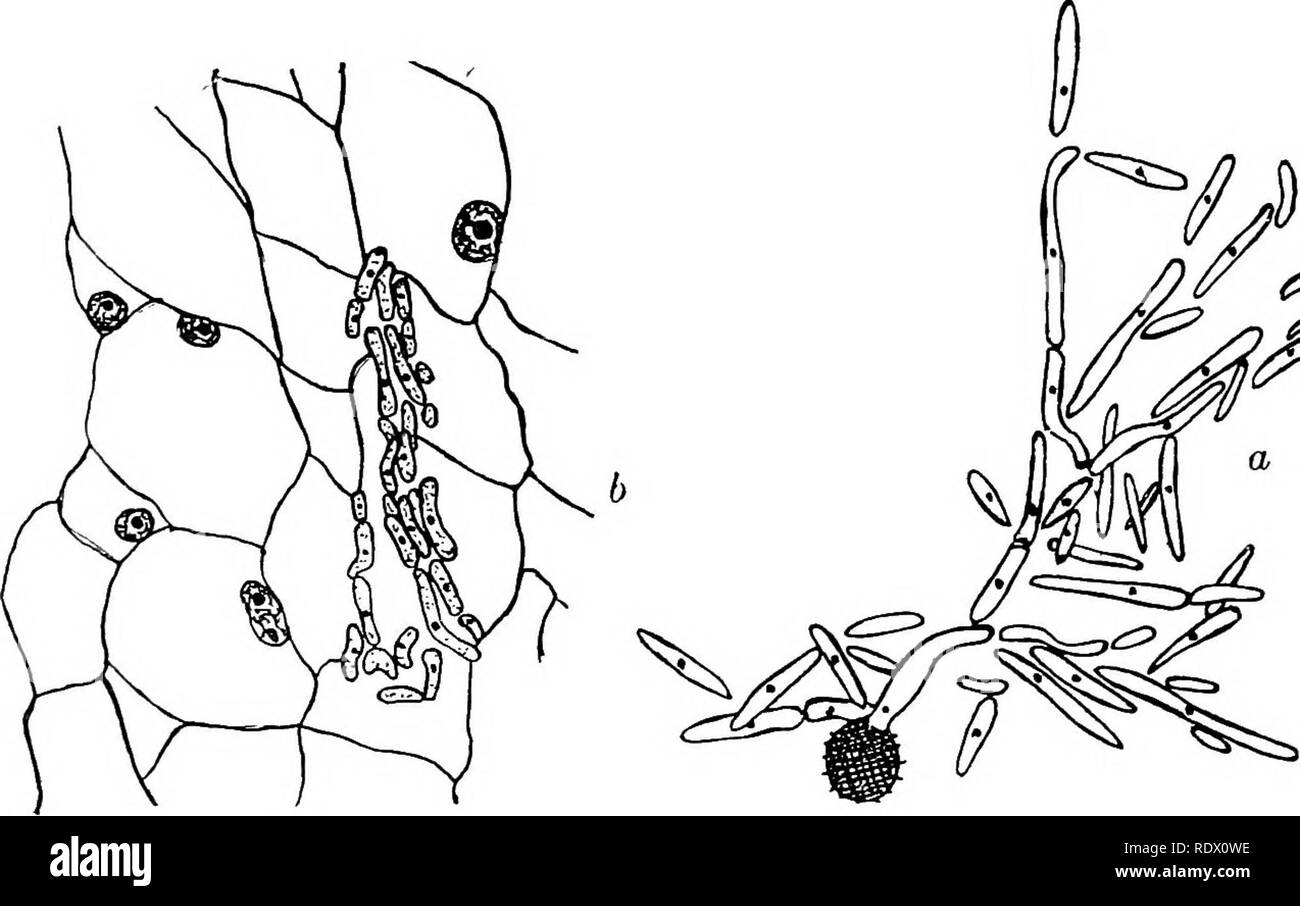 . Fungi, ascomycetes, ustilaginales, uredinales. Fungi. Federley, in 1903, described specimens of this fungus in which conjugation is followed not only by the migration of the nucleus of one of the cells concerned, but also by nuclear fusion (fig. 15s). In view of the fusion in the young spore recorded by Dangeard and by Rawitscher the details of de- velopment in this species de- mand further investigation. Ustilago Maydis, the smut of Zea Mays, induces con- siderable hypertrophy. The deformations contain a mass of gelatinous mycelium from which brand-spores are produced. When mature, the spor Stock Photohttps://www.alamy.com/image-license-details/?v=1https://www.alamy.com/fungi-ascomycetes-ustilaginales-uredinales-fungi-federley-in-1903-described-specimens-of-this-fungus-in-which-conjugation-is-followed-not-only-by-the-migration-of-the-nucleus-of-one-of-the-cells-concerned-but-also-by-nuclear-fusion-fig-15s-in-view-of-the-fusion-in-the-young-spore-recorded-by-dangeard-and-by-rawitscher-the-details-of-de-velopment-in-this-species-de-mand-further-investigation-ustilago-maydis-the-smut-of-zea-mays-induces-con-siderable-hypertrophy-the-deformations-contain-a-mass-of-gelatinous-mycelium-from-which-brand-spores-are-produced-when-mature-the-spor-image232296778.html
. Fungi, ascomycetes, ustilaginales, uredinales. Fungi. Federley, in 1903, described specimens of this fungus in which conjugation is followed not only by the migration of the nucleus of one of the cells concerned, but also by nuclear fusion (fig. 15s). In view of the fusion in the young spore recorded by Dangeard and by Rawitscher the details of de- velopment in this species de- mand further investigation. Ustilago Maydis, the smut of Zea Mays, induces con- siderable hypertrophy. The deformations contain a mass of gelatinous mycelium from which brand-spores are produced. When mature, the spor Stock Photohttps://www.alamy.com/image-license-details/?v=1https://www.alamy.com/fungi-ascomycetes-ustilaginales-uredinales-fungi-federley-in-1903-described-specimens-of-this-fungus-in-which-conjugation-is-followed-not-only-by-the-migration-of-the-nucleus-of-one-of-the-cells-concerned-but-also-by-nuclear-fusion-fig-15s-in-view-of-the-fusion-in-the-young-spore-recorded-by-dangeard-and-by-rawitscher-the-details-of-de-velopment-in-this-species-de-mand-further-investigation-ustilago-maydis-the-smut-of-zea-mays-induces-con-siderable-hypertrophy-the-deformations-contain-a-mass-of-gelatinous-mycelium-from-which-brand-spores-are-produced-when-mature-the-spor-image232296778.htmlRMRDX0WE–. Fungi, ascomycetes, ustilaginales, uredinales. Fungi. Federley, in 1903, described specimens of this fungus in which conjugation is followed not only by the migration of the nucleus of one of the cells concerned, but also by nuclear fusion (fig. 15s). In view of the fusion in the young spore recorded by Dangeard and by Rawitscher the details of de- velopment in this species de- mand further investigation. Ustilago Maydis, the smut of Zea Mays, induces con- siderable hypertrophy. The deformations contain a mass of gelatinous mycelium from which brand-spores are produced. When mature, the spor
 . Diseases of plants induced by cryptogamic parasites : introduction to the study of pathogenic Fungi, slime-Fungi, bacteria, & Algae . Plant diseases; Parasitic plants; Fungi. 268 ASCOMYCETES. Epidemics of great magnitude have been ascribed to attacks by the Botrytis-iorms of this Solerotinia. Thus on lilies in England,^ on yellow gentian,^ on male flowers of Conifers, and on the twigs of Conifers and other plants. This is especially the case in houses under glass, where the fungus, favoured by the moist atmosphere, lives as a saprophyte on dead plant-remains, and multiplies till it becom Stock Photohttps://www.alamy.com/image-license-details/?v=1https://www.alamy.com/diseases-of-plants-induced-by-cryptogamic-parasites-introduction-to-the-study-of-pathogenic-fungi-slime-fungi-bacteria-amp-algae-plant-diseases-parasitic-plants-fungi-268-ascomycetes-epidemics-of-great-magnitude-have-been-ascribed-to-attacks-by-the-botrytis-iorms-of-this-solerotinia-thus-on-lilies-in-england-on-yellow-gentian-on-male-flowers-of-conifers-and-on-the-twigs-of-conifers-and-other-plants-this-is-especially-the-case-in-houses-under-glass-where-the-fungus-favoured-by-the-moist-atmosphere-lives-as-a-saprophyte-on-dead-plant-remains-and-multiplies-till-it-becom-image216455717.html
. Diseases of plants induced by cryptogamic parasites : introduction to the study of pathogenic Fungi, slime-Fungi, bacteria, & Algae . Plant diseases; Parasitic plants; Fungi. 268 ASCOMYCETES. Epidemics of great magnitude have been ascribed to attacks by the Botrytis-iorms of this Solerotinia. Thus on lilies in England,^ on yellow gentian,^ on male flowers of Conifers, and on the twigs of Conifers and other plants. This is especially the case in houses under glass, where the fungus, favoured by the moist atmosphere, lives as a saprophyte on dead plant-remains, and multiplies till it becom Stock Photohttps://www.alamy.com/image-license-details/?v=1https://www.alamy.com/diseases-of-plants-induced-by-cryptogamic-parasites-introduction-to-the-study-of-pathogenic-fungi-slime-fungi-bacteria-amp-algae-plant-diseases-parasitic-plants-fungi-268-ascomycetes-epidemics-of-great-magnitude-have-been-ascribed-to-attacks-by-the-botrytis-iorms-of-this-solerotinia-thus-on-lilies-in-england-on-yellow-gentian-on-male-flowers-of-conifers-and-on-the-twigs-of-conifers-and-other-plants-this-is-especially-the-case-in-houses-under-glass-where-the-fungus-favoured-by-the-moist-atmosphere-lives-as-a-saprophyte-on-dead-plant-remains-and-multiplies-till-it-becom-image216455717.htmlRMPG4BD9–. Diseases of plants induced by cryptogamic parasites : introduction to the study of pathogenic Fungi, slime-Fungi, bacteria, & Algae . Plant diseases; Parasitic plants; Fungi. 268 ASCOMYCETES. Epidemics of great magnitude have been ascribed to attacks by the Botrytis-iorms of this Solerotinia. Thus on lilies in England,^ on yellow gentian,^ on male flowers of Conifers, and on the twigs of Conifers and other plants. This is especially the case in houses under glass, where the fungus, favoured by the moist atmosphere, lives as a saprophyte on dead plant-remains, and multiplies till it becom
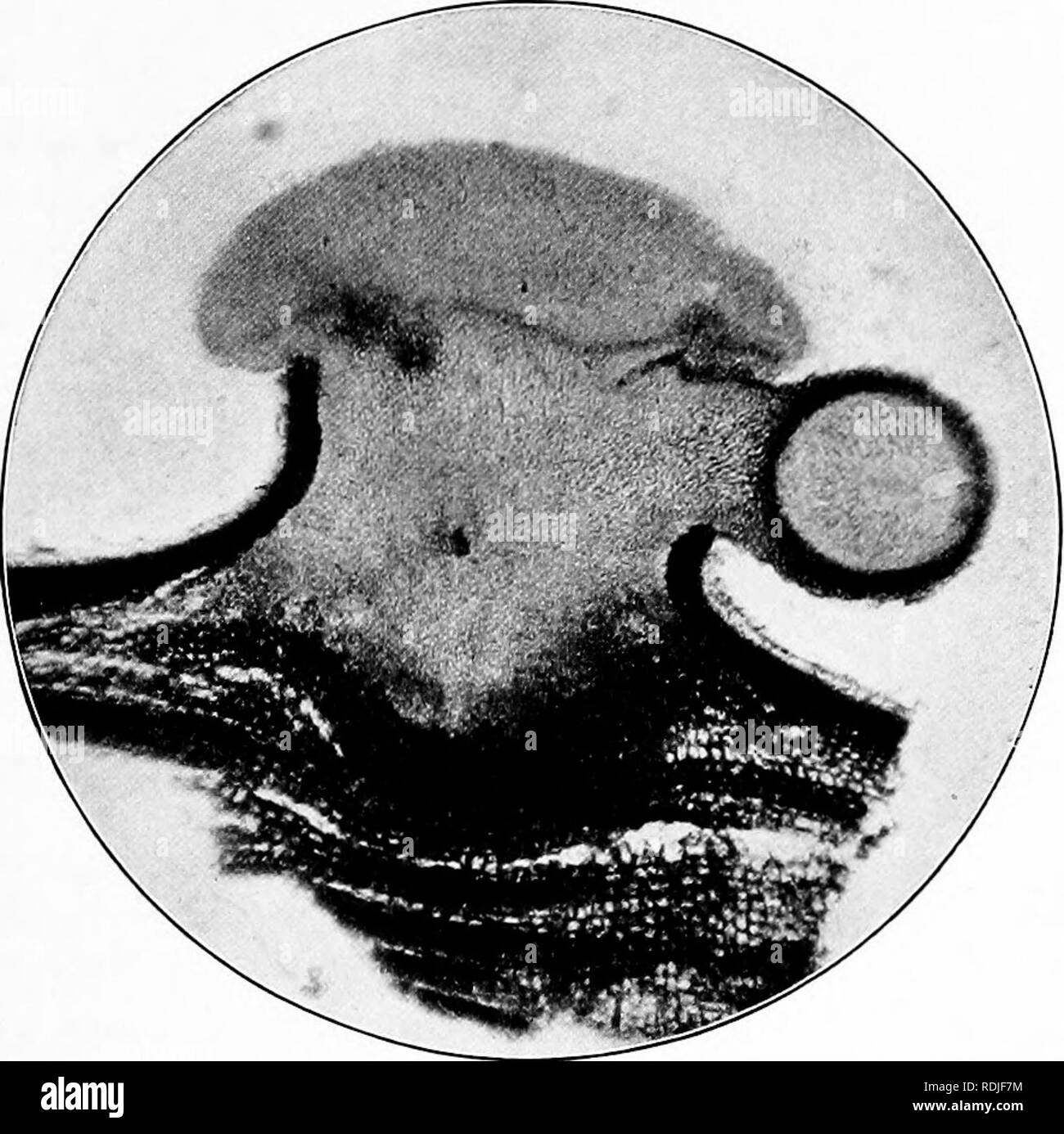 . Fungous diseases of plants : with chapters on physiology, culture methods and technique . Fungi in agriculture. ASCOMYCETES 241 generally followed later in the season by the development of peri- thecia, which latter may be differentiated in newly developed stroma, or in the stroma which has borne the Tubercularia stage. A longitudinal section of the perithecia in a related fungus is shown in Fig. 103. The wall of the perithecium consists of an interwoven layer of threads having almost a pseudoparenchymatous appearance. The asci develop from the base and sides, converging toward the apex, eac Stock Photohttps://www.alamy.com/image-license-details/?v=1https://www.alamy.com/fungous-diseases-of-plants-with-chapters-on-physiology-culture-methods-and-technique-fungi-in-agriculture-ascomycetes-241-generally-followed-later-in-the-season-by-the-development-of-peri-thecia-which-latter-may-be-differentiated-in-newly-developed-stroma-or-in-the-stroma-which-has-borne-the-tubercularia-stage-a-longitudinal-section-of-the-perithecia-in-a-related-fungus-is-shown-in-fig-103-the-wall-of-the-perithecium-consists-of-an-interwoven-layer-of-threads-having-almost-a-pseudoparenchymatous-appearance-the-asci-develop-from-the-base-and-sides-converging-toward-the-apex-eac-image232132424.html
. Fungous diseases of plants : with chapters on physiology, culture methods and technique . Fungi in agriculture. ASCOMYCETES 241 generally followed later in the season by the development of peri- thecia, which latter may be differentiated in newly developed stroma, or in the stroma which has borne the Tubercularia stage. A longitudinal section of the perithecia in a related fungus is shown in Fig. 103. The wall of the perithecium consists of an interwoven layer of threads having almost a pseudoparenchymatous appearance. The asci develop from the base and sides, converging toward the apex, eac Stock Photohttps://www.alamy.com/image-license-details/?v=1https://www.alamy.com/fungous-diseases-of-plants-with-chapters-on-physiology-culture-methods-and-technique-fungi-in-agriculture-ascomycetes-241-generally-followed-later-in-the-season-by-the-development-of-peri-thecia-which-latter-may-be-differentiated-in-newly-developed-stroma-or-in-the-stroma-which-has-borne-the-tubercularia-stage-a-longitudinal-section-of-the-perithecia-in-a-related-fungus-is-shown-in-fig-103-the-wall-of-the-perithecium-consists-of-an-interwoven-layer-of-threads-having-almost-a-pseudoparenchymatous-appearance-the-asci-develop-from-the-base-and-sides-converging-toward-the-apex-eac-image232132424.htmlRMRDJF7M–. Fungous diseases of plants : with chapters on physiology, culture methods and technique . Fungi in agriculture. ASCOMYCETES 241 generally followed later in the season by the development of peri- thecia, which latter may be differentiated in newly developed stroma, or in the stroma which has borne the Tubercularia stage. A longitudinal section of the perithecia in a related fungus is shown in Fig. 103. The wall of the perithecium consists of an interwoven layer of threads having almost a pseudoparenchymatous appearance. The asci develop from the base and sides, converging toward the apex, eac
 . Fungous diseases of plants : with chapters on physiology, culture methods and technique . Fungi in agriculture. ASCOMYCETES 245 The fungus. The fungus shows an interesting polymorphism, first producing a conidial stage upon the ovule sac, later the sclerotial or true ergot stage in place of the grain, and finally completing its life cycle by developing special sporophores from this sclerotium after a long period of rest has been undergone. The fungus is supposed to gain entrance to the host at the base of the ovule sac or carpel, penetrating the latter and developing through it or over it as Stock Photohttps://www.alamy.com/image-license-details/?v=1https://www.alamy.com/fungous-diseases-of-plants-with-chapters-on-physiology-culture-methods-and-technique-fungi-in-agriculture-ascomycetes-245-the-fungus-the-fungus-shows-an-interesting-polymorphism-first-producing-a-conidial-stage-upon-the-ovule-sac-later-the-sclerotial-or-true-ergot-stage-in-place-of-the-grain-and-finally-completing-its-life-cycle-by-developing-special-sporophores-from-this-sclerotium-after-a-long-period-of-rest-has-been-undergone-the-fungus-is-supposed-to-gain-entrance-to-the-host-at-the-base-of-the-ovule-sac-or-carpel-penetrating-the-latter-and-developing-through-it-or-over-it-as-image216446460.html
. Fungous diseases of plants : with chapters on physiology, culture methods and technique . Fungi in agriculture. ASCOMYCETES 245 The fungus. The fungus shows an interesting polymorphism, first producing a conidial stage upon the ovule sac, later the sclerotial or true ergot stage in place of the grain, and finally completing its life cycle by developing special sporophores from this sclerotium after a long period of rest has been undergone. The fungus is supposed to gain entrance to the host at the base of the ovule sac or carpel, penetrating the latter and developing through it or over it as Stock Photohttps://www.alamy.com/image-license-details/?v=1https://www.alamy.com/fungous-diseases-of-plants-with-chapters-on-physiology-culture-methods-and-technique-fungi-in-agriculture-ascomycetes-245-the-fungus-the-fungus-shows-an-interesting-polymorphism-first-producing-a-conidial-stage-upon-the-ovule-sac-later-the-sclerotial-or-true-ergot-stage-in-place-of-the-grain-and-finally-completing-its-life-cycle-by-developing-special-sporophores-from-this-sclerotium-after-a-long-period-of-rest-has-been-undergone-the-fungus-is-supposed-to-gain-entrance-to-the-host-at-the-base-of-the-ovule-sac-or-carpel-penetrating-the-latter-and-developing-through-it-or-over-it-as-image216446460.htmlRMPG3YJM–. Fungous diseases of plants : with chapters on physiology, culture methods and technique . Fungi in agriculture. ASCOMYCETES 245 The fungus. The fungus shows an interesting polymorphism, first producing a conidial stage upon the ovule sac, later the sclerotial or true ergot stage in place of the grain, and finally completing its life cycle by developing special sporophores from this sclerotium after a long period of rest has been undergone. The fungus is supposed to gain entrance to the host at the base of the ovule sac or carpel, penetrating the latter and developing through it or over it as
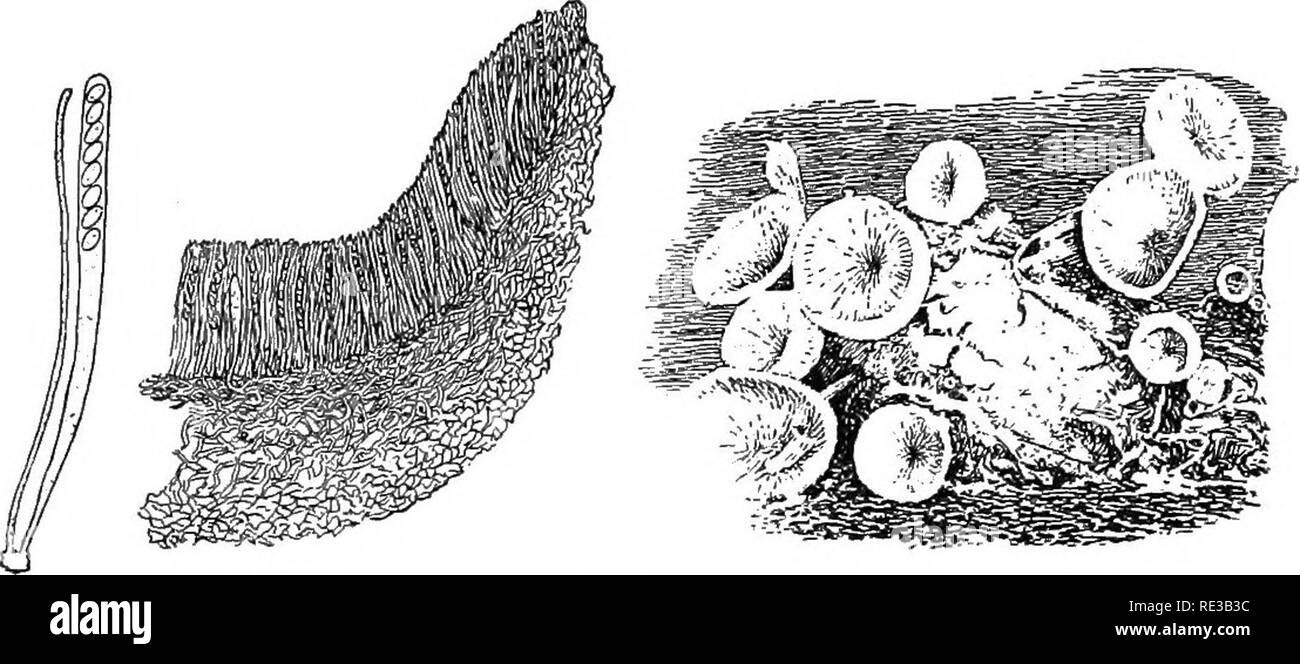 . Practical botany. Botany. THE SAC FUNGI (ASCOMYCETES) 227 organs of another ascomycete, Sclerotinia (Fig. 183). In case of both Peziza and Sclerotinia, the cujjs are external indica- tions of a much larger internal growth of the fungus. In Sclerotinia, commonly called the brown rot of the stone fruits (peach, plum, apricot, cherrj-), the infection of the host long precedes the production of cups. Mycelial hyphte penetrate the fruit or the flo'er and grow extensively in it, often extending to the twig. After a period of such growth there appear upon the surface of the fruit, which is now sh Stock Photohttps://www.alamy.com/image-license-details/?v=1https://www.alamy.com/practical-botany-botany-the-sac-fungi-ascomycetes-227-organs-of-another-ascomycete-sclerotinia-fig-183-in-case-of-both-peziza-and-sclerotinia-the-cujjs-are-external-indica-tions-of-a-much-larger-internal-growth-of-the-fungus-in-sclerotinia-commonly-called-the-brown-rot-of-the-stone-fruits-peach-plum-apricot-cherrj-the-infection-of-the-host-long-precedes-the-production-of-cups-mycelial-hyphte-penetrate-the-fruit-or-the-floer-and-grow-extensively-in-it-often-extending-to-the-twig-after-a-period-of-such-growth-there-appear-upon-the-surface-of-the-fruit-which-is-now-sh-image232414544.html
. Practical botany. Botany. THE SAC FUNGI (ASCOMYCETES) 227 organs of another ascomycete, Sclerotinia (Fig. 183). In case of both Peziza and Sclerotinia, the cujjs are external indica- tions of a much larger internal growth of the fungus. In Sclerotinia, commonly called the brown rot of the stone fruits (peach, plum, apricot, cherrj-), the infection of the host long precedes the production of cups. Mycelial hyphte penetrate the fruit or the flo'er and grow extensively in it, often extending to the twig. After a period of such growth there appear upon the surface of the fruit, which is now sh Stock Photohttps://www.alamy.com/image-license-details/?v=1https://www.alamy.com/practical-botany-botany-the-sac-fungi-ascomycetes-227-organs-of-another-ascomycete-sclerotinia-fig-183-in-case-of-both-peziza-and-sclerotinia-the-cujjs-are-external-indica-tions-of-a-much-larger-internal-growth-of-the-fungus-in-sclerotinia-commonly-called-the-brown-rot-of-the-stone-fruits-peach-plum-apricot-cherrj-the-infection-of-the-host-long-precedes-the-production-of-cups-mycelial-hyphte-penetrate-the-fruit-or-the-floer-and-grow-extensively-in-it-often-extending-to-the-twig-after-a-period-of-such-growth-there-appear-upon-the-surface-of-the-fruit-which-is-now-sh-image232414544.htmlRMRE3B3C–. Practical botany. Botany. THE SAC FUNGI (ASCOMYCETES) 227 organs of another ascomycete, Sclerotinia (Fig. 183). In case of both Peziza and Sclerotinia, the cujjs are external indica- tions of a much larger internal growth of the fungus. In Sclerotinia, commonly called the brown rot of the stone fruits (peach, plum, apricot, cherrj-), the infection of the host long precedes the production of cups. Mycelial hyphte penetrate the fruit or the flo'er and grow extensively in it, often extending to the twig. After a period of such growth there appear upon the surface of the fruit, which is now sh
 . Fungous diseases of plants : with chapters on physiology, culture methods and technique . Fungi in agriculture. ASCOMYCETES 275 adheres closely to the underlying wood. Moreover, toe develop- ment of a callus layer at the edge of the dead spot gives a further emphasis to the depression produced by the death and shrinking of the tissues within t-he canker spots. The canker spots are sup- posed to persist for at least two years. The mycelium of the fun- gus may be found in the inner bark and cambium. As previously suggested, the pustules of the fungus break through the bark in these cankered sp Stock Photohttps://www.alamy.com/image-license-details/?v=1https://www.alamy.com/fungous-diseases-of-plants-with-chapters-on-physiology-culture-methods-and-technique-fungi-in-agriculture-ascomycetes-275-adheres-closely-to-the-underlying-wood-moreover-toe-develop-ment-of-a-callus-layer-at-the-edge-of-the-dead-spot-gives-a-further-emphasis-to-the-depression-produced-by-the-death-and-shrinking-of-the-tissues-within-t-he-canker-spots-the-canker-spots-are-sup-posed-to-persist-for-at-least-two-years-the-mycelium-of-the-fun-gus-may-be-found-in-the-inner-bark-and-cambium-as-previously-suggested-the-pustules-of-the-fungus-break-through-the-bark-in-these-cankered-sp-image216446378.html
. Fungous diseases of plants : with chapters on physiology, culture methods and technique . Fungi in agriculture. ASCOMYCETES 275 adheres closely to the underlying wood. Moreover, toe develop- ment of a callus layer at the edge of the dead spot gives a further emphasis to the depression produced by the death and shrinking of the tissues within t-he canker spots. The canker spots are sup- posed to persist for at least two years. The mycelium of the fun- gus may be found in the inner bark and cambium. As previously suggested, the pustules of the fungus break through the bark in these cankered sp Stock Photohttps://www.alamy.com/image-license-details/?v=1https://www.alamy.com/fungous-diseases-of-plants-with-chapters-on-physiology-culture-methods-and-technique-fungi-in-agriculture-ascomycetes-275-adheres-closely-to-the-underlying-wood-moreover-toe-develop-ment-of-a-callus-layer-at-the-edge-of-the-dead-spot-gives-a-further-emphasis-to-the-depression-produced-by-the-death-and-shrinking-of-the-tissues-within-t-he-canker-spots-the-canker-spots-are-sup-posed-to-persist-for-at-least-two-years-the-mycelium-of-the-fun-gus-may-be-found-in-the-inner-bark-and-cambium-as-previously-suggested-the-pustules-of-the-fungus-break-through-the-bark-in-these-cankered-sp-image216446378.htmlRMPG3YFP–. Fungous diseases of plants : with chapters on physiology, culture methods and technique . Fungi in agriculture. ASCOMYCETES 275 adheres closely to the underlying wood. Moreover, toe develop- ment of a callus layer at the edge of the dead spot gives a further emphasis to the depression produced by the death and shrinking of the tissues within t-he canker spots. The canker spots are sup- posed to persist for at least two years. The mycelium of the fun- gus may be found in the inner bark and cambium. As previously suggested, the pustules of the fungus break through the bark in these cankered sp
 . Diseases of plants induced by cryptogamic parasites : introduction to the study of pathogenic Fungi, slime-Fungi, bacteria, & Algae . Plant diseases; Parasitic plants; Fungi. 268 ASCOMYCETES. Epidemics of great magnitude have been ascribed to attacks by the Botrytis-iorms of this Solerotinia. Thus on lilies in England,^ on yellow gentian,^ on male flowers of Conifers, and on the twigs of Conifers and other plants. This is especially the case in houses under glass, where the fungus, favoured by the moist atmosphere, lives as a saprophyte on dead plant-remains, and multiplies till it becom Stock Photohttps://www.alamy.com/image-license-details/?v=1https://www.alamy.com/diseases-of-plants-induced-by-cryptogamic-parasites-introduction-to-the-study-of-pathogenic-fungi-slime-fungi-bacteria-amp-algae-plant-diseases-parasitic-plants-fungi-268-ascomycetes-epidemics-of-great-magnitude-have-been-ascribed-to-attacks-by-the-botrytis-iorms-of-this-solerotinia-thus-on-lilies-in-england-on-yellow-gentian-on-male-flowers-of-conifers-and-on-the-twigs-of-conifers-and-other-plants-this-is-especially-the-case-in-houses-under-glass-where-the-fungus-favoured-by-the-moist-atmosphere-lives-as-a-saprophyte-on-dead-plant-remains-and-multiplies-till-it-becom-image232017198.html
. Diseases of plants induced by cryptogamic parasites : introduction to the study of pathogenic Fungi, slime-Fungi, bacteria, & Algae . Plant diseases; Parasitic plants; Fungi. 268 ASCOMYCETES. Epidemics of great magnitude have been ascribed to attacks by the Botrytis-iorms of this Solerotinia. Thus on lilies in England,^ on yellow gentian,^ on male flowers of Conifers, and on the twigs of Conifers and other plants. This is especially the case in houses under glass, where the fungus, favoured by the moist atmosphere, lives as a saprophyte on dead plant-remains, and multiplies till it becom Stock Photohttps://www.alamy.com/image-license-details/?v=1https://www.alamy.com/diseases-of-plants-induced-by-cryptogamic-parasites-introduction-to-the-study-of-pathogenic-fungi-slime-fungi-bacteria-amp-algae-plant-diseases-parasitic-plants-fungi-268-ascomycetes-epidemics-of-great-magnitude-have-been-ascribed-to-attacks-by-the-botrytis-iorms-of-this-solerotinia-thus-on-lilies-in-england-on-yellow-gentian-on-male-flowers-of-conifers-and-on-the-twigs-of-conifers-and-other-plants-this-is-especially-the-case-in-houses-under-glass-where-the-fungus-favoured-by-the-moist-atmosphere-lives-as-a-saprophyte-on-dead-plant-remains-and-multiplies-till-it-becom-image232017198.htmlRMRDD88E–. Diseases of plants induced by cryptogamic parasites : introduction to the study of pathogenic Fungi, slime-Fungi, bacteria, & Algae . Plant diseases; Parasitic plants; Fungi. 268 ASCOMYCETES. Epidemics of great magnitude have been ascribed to attacks by the Botrytis-iorms of this Solerotinia. Thus on lilies in England,^ on yellow gentian,^ on male flowers of Conifers, and on the twigs of Conifers and other plants. This is especially the case in houses under glass, where the fungus, favoured by the moist atmosphere, lives as a saprophyte on dead plant-remains, and multiplies till it becom
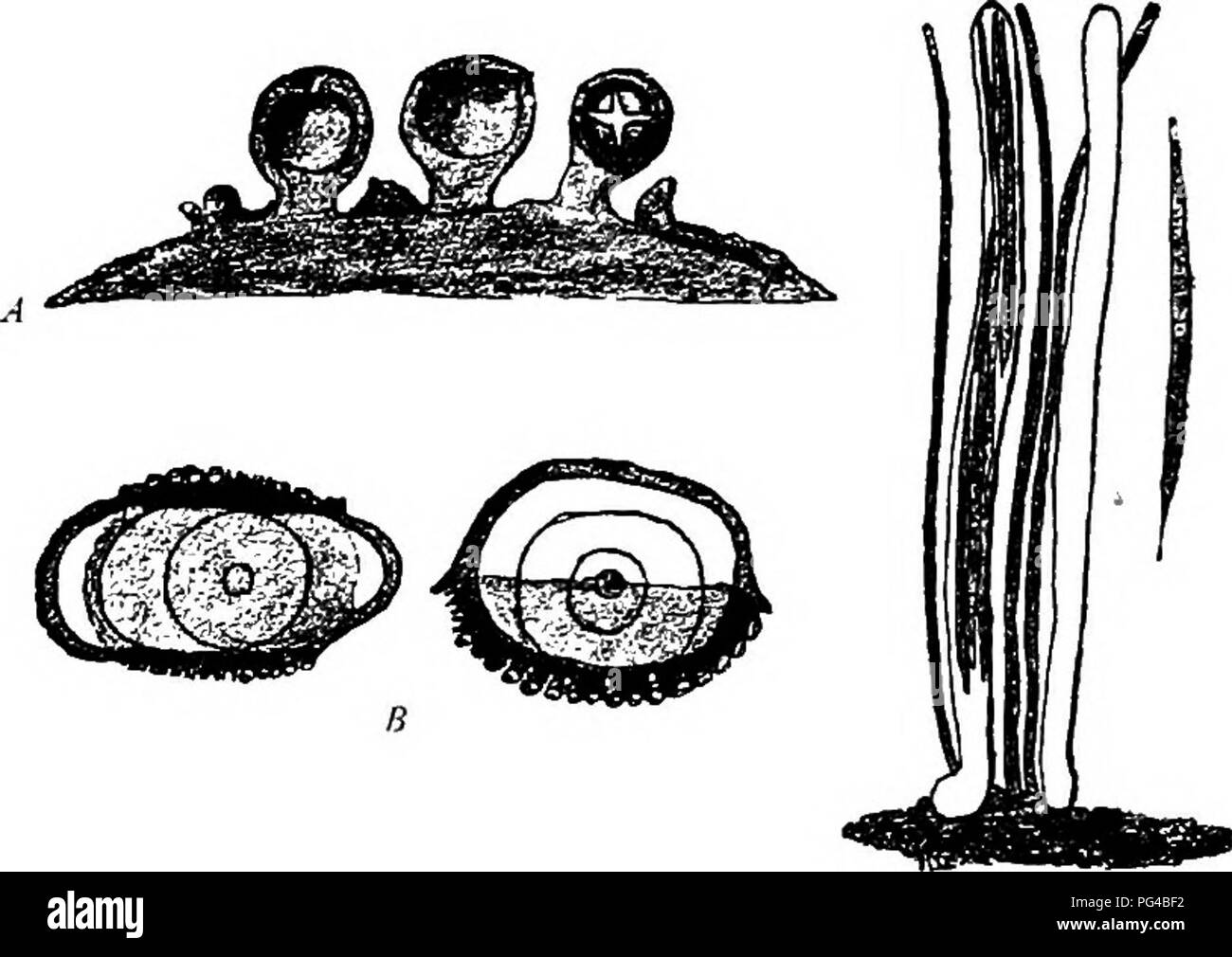 . Diseases of plants induced by cryptogamic parasites : introduction to the study of pathogenic Fungi, slime-Fungi, bacteria, & Algae . Plant diseases; Parasitic plants; Fungi. 250 ASCOMYCETES. Scleroderris. A ^black stroma is formed in the bark of twigs attacked by this fungus, and thence the apothecia break out in great numbers, at first as closed spheres, later as stalked open cups with finely lobed rims. The asci are cylindrical or club- m Fig. 13B-'Scleroderris full' rtinosa on living twig of Salix Caprea. (v. Tubeuf del.). Fig. 134.— i^clerodei-^'is faliginosa ou living twig of Salix Stock Photohttps://www.alamy.com/image-license-details/?v=1https://www.alamy.com/diseases-of-plants-induced-by-cryptogamic-parasites-introduction-to-the-study-of-pathogenic-fungi-slime-fungi-bacteria-amp-algae-plant-diseases-parasitic-plants-fungi-250-ascomycetes-scleroderris-a-black-stroma-is-formed-in-the-bark-of-twigs-attacked-by-this-fungus-and-thence-the-apothecia-break-out-in-great-numbers-at-first-as-closed-spheres-later-as-stalked-open-cups-with-finely-lobed-rims-the-asci-are-cylindrical-or-club-m-fig-13b-scleroderris-full-rtinosa-on-living-twig-of-salix-caprea-v-tubeuf-del-fig-134-iclerodei-is-faliginosa-ou-living-twig-of-salix-image216455766.html
. Diseases of plants induced by cryptogamic parasites : introduction to the study of pathogenic Fungi, slime-Fungi, bacteria, & Algae . Plant diseases; Parasitic plants; Fungi. 250 ASCOMYCETES. Scleroderris. A ^black stroma is formed in the bark of twigs attacked by this fungus, and thence the apothecia break out in great numbers, at first as closed spheres, later as stalked open cups with finely lobed rims. The asci are cylindrical or club- m Fig. 13B-'Scleroderris full' rtinosa on living twig of Salix Caprea. (v. Tubeuf del.). Fig. 134.— i^clerodei-^'is faliginosa ou living twig of Salix Stock Photohttps://www.alamy.com/image-license-details/?v=1https://www.alamy.com/diseases-of-plants-induced-by-cryptogamic-parasites-introduction-to-the-study-of-pathogenic-fungi-slime-fungi-bacteria-amp-algae-plant-diseases-parasitic-plants-fungi-250-ascomycetes-scleroderris-a-black-stroma-is-formed-in-the-bark-of-twigs-attacked-by-this-fungus-and-thence-the-apothecia-break-out-in-great-numbers-at-first-as-closed-spheres-later-as-stalked-open-cups-with-finely-lobed-rims-the-asci-are-cylindrical-or-club-m-fig-13b-scleroderris-full-rtinosa-on-living-twig-of-salix-caprea-v-tubeuf-del-fig-134-iclerodei-is-faliginosa-ou-living-twig-of-salix-image216455766.htmlRMPG4BF2–. Diseases of plants induced by cryptogamic parasites : introduction to the study of pathogenic Fungi, slime-Fungi, bacteria, & Algae . Plant diseases; Parasitic plants; Fungi. 250 ASCOMYCETES. Scleroderris. A ^black stroma is formed in the bark of twigs attacked by this fungus, and thence the apothecia break out in great numbers, at first as closed spheres, later as stalked open cups with finely lobed rims. The asci are cylindrical or club- m Fig. 13B-'Scleroderris full' rtinosa on living twig of Salix Caprea. (v. Tubeuf del.). Fig. 134.— i^clerodei-^'is faliginosa ou living twig of Salix
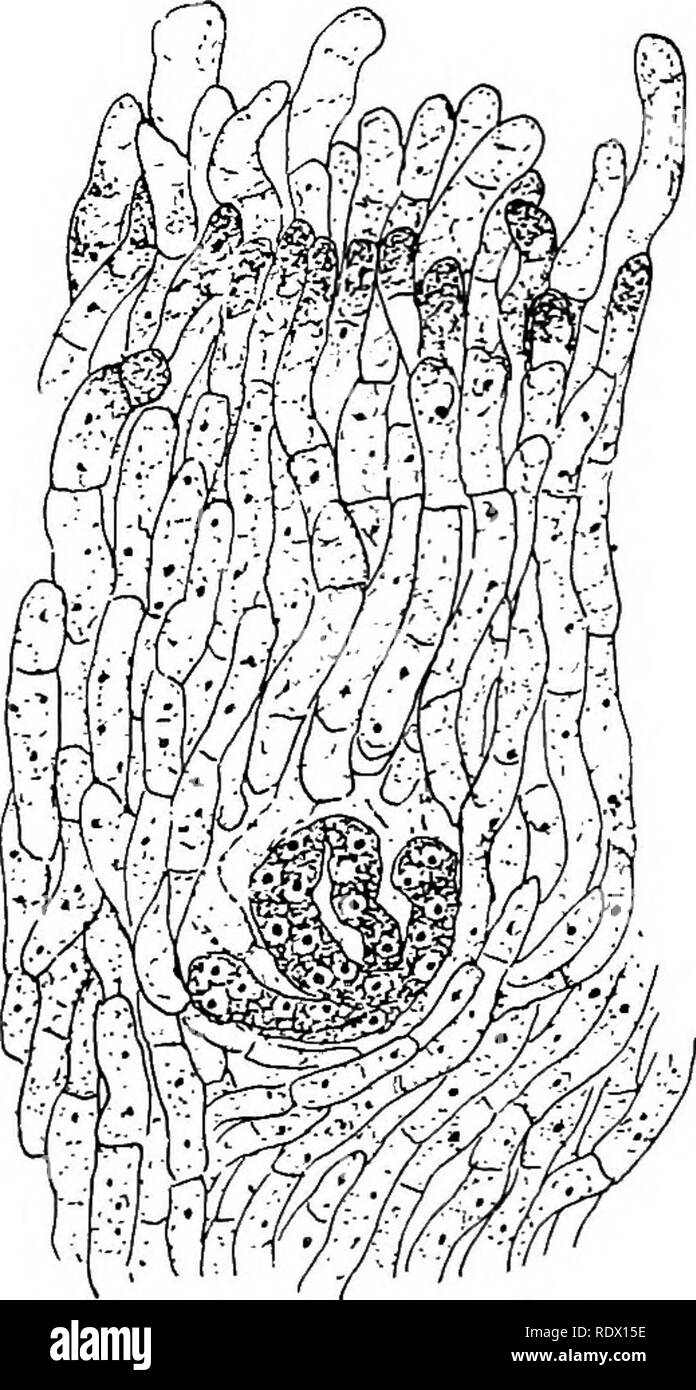 . Fungi, ascomycetes, ustilaginales, uredinales. Fungi. I/O PYRENOMYCETES [CH. of conidiophores, from which small oval conidia are abstricted. In Xylaria these form a white coating, in marked contrast to the older black portions of the stroma, where the perithecia are maturing, and justify the name candle-snuff fungus, applied to some of the commoner species. If, in either genus, the stroma be sectioned during the conidial stage, nests of small hyphae, similar to those in Poronia, will be found, and are the first indica- tions of the perithecia. Sometimes a stouter hypha with larger nuclei, pr Stock Photohttps://www.alamy.com/image-license-details/?v=1https://www.alamy.com/fungi-ascomycetes-ustilaginales-uredinales-fungi-io-pyrenomycetes-ch-of-conidiophores-from-which-small-oval-conidia-are-abstricted-in-xylaria-these-form-a-white-coating-in-marked-contrast-to-the-older-black-portions-of-the-stroma-where-the-perithecia-are-maturing-and-justify-the-name-candle-snuff-fungus-applied-to-some-of-the-commoner-species-if-in-either-genus-the-stroma-be-sectioned-during-the-conidial-stage-nests-of-small-hyphae-similar-to-those-in-poronia-will-be-found-and-are-the-first-indica-tions-of-the-perithecia-sometimes-a-stouter-hypha-with-larger-nuclei-pr-image232297002.html
. Fungi, ascomycetes, ustilaginales, uredinales. Fungi. I/O PYRENOMYCETES [CH. of conidiophores, from which small oval conidia are abstricted. In Xylaria these form a white coating, in marked contrast to the older black portions of the stroma, where the perithecia are maturing, and justify the name candle-snuff fungus, applied to some of the commoner species. If, in either genus, the stroma be sectioned during the conidial stage, nests of small hyphae, similar to those in Poronia, will be found, and are the first indica- tions of the perithecia. Sometimes a stouter hypha with larger nuclei, pr Stock Photohttps://www.alamy.com/image-license-details/?v=1https://www.alamy.com/fungi-ascomycetes-ustilaginales-uredinales-fungi-io-pyrenomycetes-ch-of-conidiophores-from-which-small-oval-conidia-are-abstricted-in-xylaria-these-form-a-white-coating-in-marked-contrast-to-the-older-black-portions-of-the-stroma-where-the-perithecia-are-maturing-and-justify-the-name-candle-snuff-fungus-applied-to-some-of-the-commoner-species-if-in-either-genus-the-stroma-be-sectioned-during-the-conidial-stage-nests-of-small-hyphae-similar-to-those-in-poronia-will-be-found-and-are-the-first-indica-tions-of-the-perithecia-sometimes-a-stouter-hypha-with-larger-nuclei-pr-image232297002.htmlRMRDX15E–. Fungi, ascomycetes, ustilaginales, uredinales. Fungi. I/O PYRENOMYCETES [CH. of conidiophores, from which small oval conidia are abstricted. In Xylaria these form a white coating, in marked contrast to the older black portions of the stroma, where the perithecia are maturing, and justify the name candle-snuff fungus, applied to some of the commoner species. If, in either genus, the stroma be sectioned during the conidial stage, nests of small hyphae, similar to those in Poronia, will be found, and are the first indica- tions of the perithecia. Sometimes a stouter hypha with larger nuclei, pr
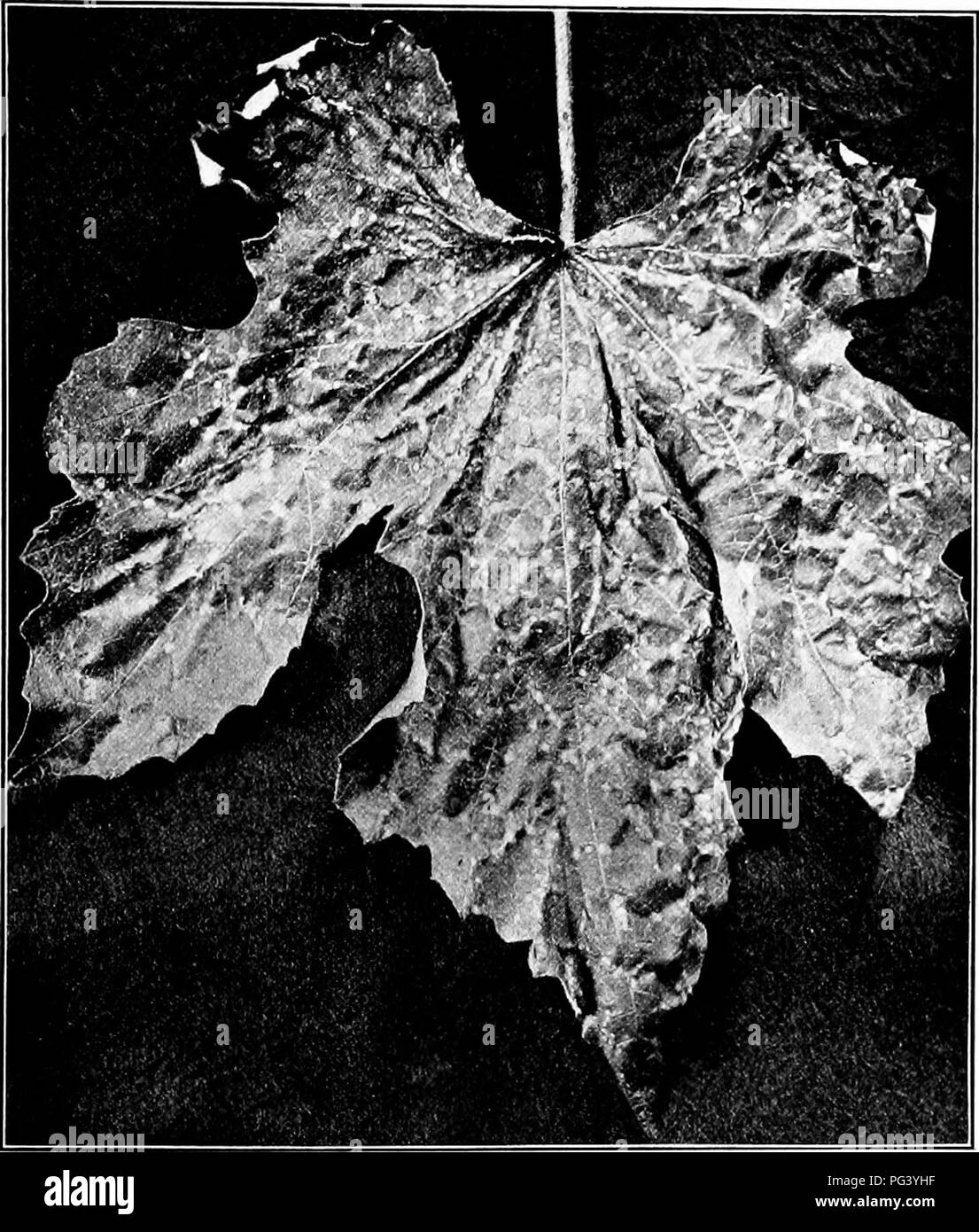 . Fungous diseases of plants : with chapters on physiology, culture methods and technique . Fungi in agriculture. ASCOMYCETES 257 mass of mycelium which arises beneath the epidermis. It is broadly elliptical, with a rather thick wall and no indication of a beak (Fig. 112, a). The conidiophores are short and simple, bear- ing spores — ovate or elliptical — measuring ordinarily 8-10 x 7- Sfi. In moist weather the spores are pushed out in vermiform. Fig. iii. Phyllosticta Stage of the Black Rot Fungus (Photograph by H. H. Whetzel) masses and upon dissemination they are capable of immediate germin Stock Photohttps://www.alamy.com/image-license-details/?v=1https://www.alamy.com/fungous-diseases-of-plants-with-chapters-on-physiology-culture-methods-and-technique-fungi-in-agriculture-ascomycetes-257-mass-of-mycelium-which-arises-beneath-the-epidermis-it-is-broadly-elliptical-with-a-rather-thick-wall-and-no-indication-of-a-beak-fig-112-a-the-conidiophores-are-short-and-simple-bear-ing-spores-ovate-or-elliptical-measuring-ordinarily-8-10-x-7-sfi-in-moist-weather-the-spores-are-pushed-out-in-vermiform-fig-iii-phyllosticta-stage-of-the-black-rot-fungus-photograph-by-h-h-whetzel-masses-and-upon-dissemination-they-are-capable-of-immediate-germin-image216446427.html
. Fungous diseases of plants : with chapters on physiology, culture methods and technique . Fungi in agriculture. ASCOMYCETES 257 mass of mycelium which arises beneath the epidermis. It is broadly elliptical, with a rather thick wall and no indication of a beak (Fig. 112, a). The conidiophores are short and simple, bear- ing spores — ovate or elliptical — measuring ordinarily 8-10 x 7- Sfi. In moist weather the spores are pushed out in vermiform. Fig. iii. Phyllosticta Stage of the Black Rot Fungus (Photograph by H. H. Whetzel) masses and upon dissemination they are capable of immediate germin Stock Photohttps://www.alamy.com/image-license-details/?v=1https://www.alamy.com/fungous-diseases-of-plants-with-chapters-on-physiology-culture-methods-and-technique-fungi-in-agriculture-ascomycetes-257-mass-of-mycelium-which-arises-beneath-the-epidermis-it-is-broadly-elliptical-with-a-rather-thick-wall-and-no-indication-of-a-beak-fig-112-a-the-conidiophores-are-short-and-simple-bear-ing-spores-ovate-or-elliptical-measuring-ordinarily-8-10-x-7-sfi-in-moist-weather-the-spores-are-pushed-out-in-vermiform-fig-iii-phyllosticta-stage-of-the-black-rot-fungus-photograph-by-h-h-whetzel-masses-and-upon-dissemination-they-are-capable-of-immediate-germin-image216446427.htmlRMPG3YHF–. Fungous diseases of plants : with chapters on physiology, culture methods and technique . Fungi in agriculture. ASCOMYCETES 257 mass of mycelium which arises beneath the epidermis. It is broadly elliptical, with a rather thick wall and no indication of a beak (Fig. 112, a). The conidiophores are short and simple, bear- ing spores — ovate or elliptical — measuring ordinarily 8-10 x 7- Sfi. In moist weather the spores are pushed out in vermiform. Fig. iii. Phyllosticta Stage of the Black Rot Fungus (Photograph by H. H. Whetzel) masses and upon dissemination they are capable of immediate germin
 . Fungous diseases of plants : with chapters on physiology, culture methods and technique . Fungi in agriculture. ASCOMYCETES 197 more at length, may begin and develop in various ways when Botrytis is the cause, but it is finally known by the complete collapse of the lettuce heads due to the death of the stem and leaf bases. The conidial stage is also associated with various damping-off diseases, and it is believed by Smith to be the organism studied by Marshall Ward as the cause of an important lily disease.1 In all cases the conidial stage of the fungus may develop abundantly upon the dead p Stock Photohttps://www.alamy.com/image-license-details/?v=1https://www.alamy.com/fungous-diseases-of-plants-with-chapters-on-physiology-culture-methods-and-technique-fungi-in-agriculture-ascomycetes-197-more-at-length-may-begin-and-develop-in-various-ways-when-botrytis-is-the-cause-but-it-is-finally-known-by-the-complete-collapse-of-the-lettuce-heads-due-to-the-death-of-the-stem-and-leaf-bases-the-conidial-stage-is-also-associated-with-various-damping-off-diseases-and-it-is-believed-by-smith-to-be-the-organism-studied-by-marshall-ward-as-the-cause-of-an-important-lily-disease1-in-all-cases-the-conidial-stage-of-the-fungus-may-develop-abundantly-upon-the-dead-p-image232132619.html
. Fungous diseases of plants : with chapters on physiology, culture methods and technique . Fungi in agriculture. ASCOMYCETES 197 more at length, may begin and develop in various ways when Botrytis is the cause, but it is finally known by the complete collapse of the lettuce heads due to the death of the stem and leaf bases. The conidial stage is also associated with various damping-off diseases, and it is believed by Smith to be the organism studied by Marshall Ward as the cause of an important lily disease.1 In all cases the conidial stage of the fungus may develop abundantly upon the dead p Stock Photohttps://www.alamy.com/image-license-details/?v=1https://www.alamy.com/fungous-diseases-of-plants-with-chapters-on-physiology-culture-methods-and-technique-fungi-in-agriculture-ascomycetes-197-more-at-length-may-begin-and-develop-in-various-ways-when-botrytis-is-the-cause-but-it-is-finally-known-by-the-complete-collapse-of-the-lettuce-heads-due-to-the-death-of-the-stem-and-leaf-bases-the-conidial-stage-is-also-associated-with-various-damping-off-diseases-and-it-is-believed-by-smith-to-be-the-organism-studied-by-marshall-ward-as-the-cause-of-an-important-lily-disease1-in-all-cases-the-conidial-stage-of-the-fungus-may-develop-abundantly-upon-the-dead-p-image232132619.htmlRMRDJFEK–. Fungous diseases of plants : with chapters on physiology, culture methods and technique . Fungi in agriculture. ASCOMYCETES 197 more at length, may begin and develop in various ways when Botrytis is the cause, but it is finally known by the complete collapse of the lettuce heads due to the death of the stem and leaf bases. The conidial stage is also associated with various damping-off diseases, and it is believed by Smith to be the organism studied by Marshall Ward as the cause of an important lily disease.1 In all cases the conidial stage of the fungus may develop abundantly upon the dead p
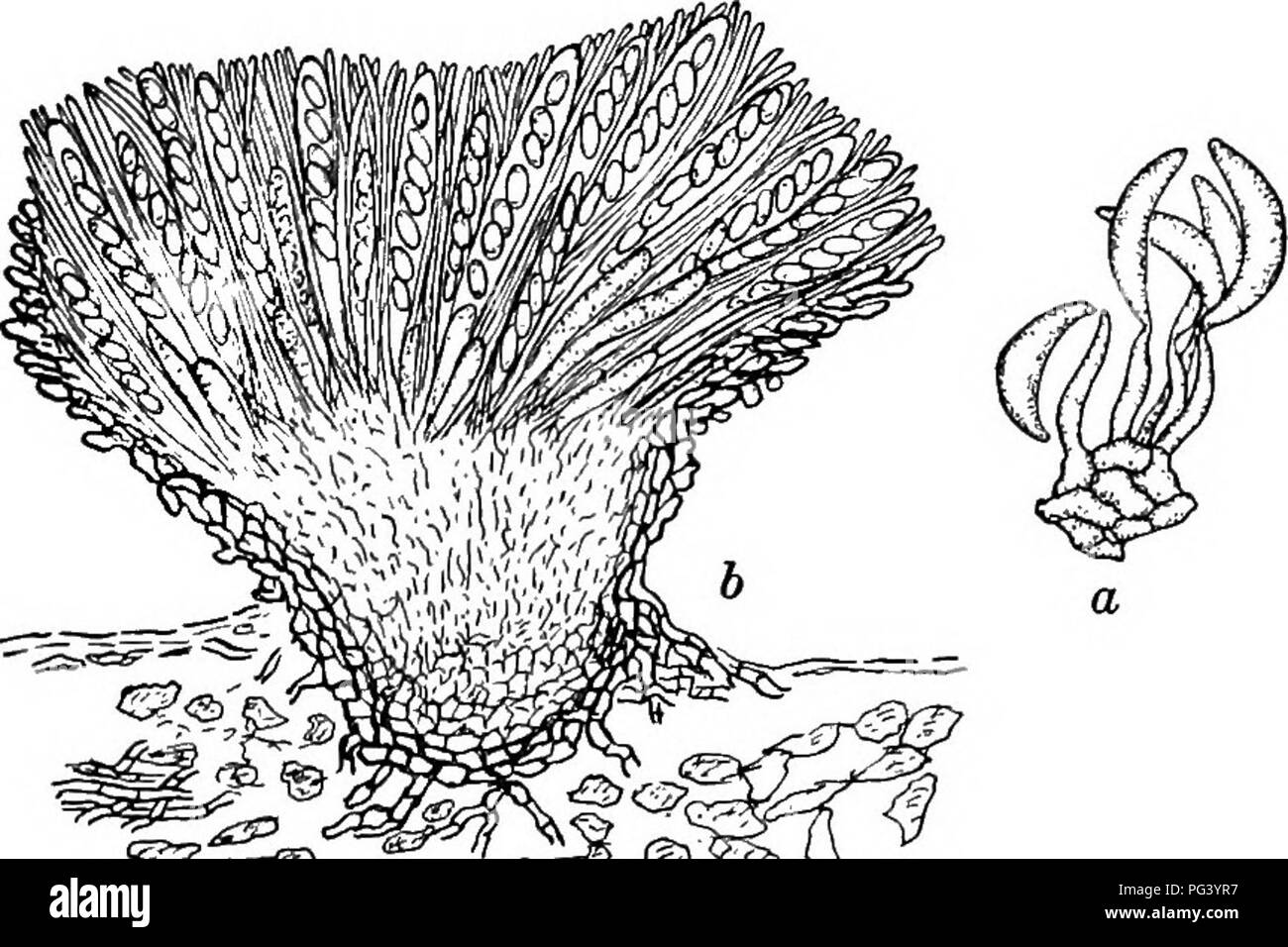 . Fungous diseases of plants : with chapters on physiology, culture methods and technique . Fungi in agriculture. ASCOMYCETES 207 shown in Fig. 80, b. The asci are club-shaped and bear eight hyaline ovoidal spores. The paraphyses are simple or branched, sometimes once-septate and slightly club-shaped. This fungus shows in pure culture certain growth characteristics which seem to differentiate it somewhat sharply from other species of Glceosporium. In the first place it grows slowly upon nutrient agar, several months being required to produce a colony of several millimeters in extent. The hypha Stock Photohttps://www.alamy.com/image-license-details/?v=1https://www.alamy.com/fungous-diseases-of-plants-with-chapters-on-physiology-culture-methods-and-technique-fungi-in-agriculture-ascomycetes-207-shown-in-fig-80-b-the-asci-are-club-shaped-and-bear-eight-hyaline-ovoidal-spores-the-paraphyses-are-simple-or-branched-sometimes-once-septate-and-slightly-club-shaped-this-fungus-shows-in-pure-culture-certain-growth-characteristics-which-seem-to-differentiate-it-somewhat-sharply-from-other-species-of-glceosporium-in-the-first-place-it-grows-slowly-upon-nutrient-agar-several-months-being-required-to-produce-a-colony-of-several-millimeters-in-extent-the-hypha-image216446587.html
. Fungous diseases of plants : with chapters on physiology, culture methods and technique . Fungi in agriculture. ASCOMYCETES 207 shown in Fig. 80, b. The asci are club-shaped and bear eight hyaline ovoidal spores. The paraphyses are simple or branched, sometimes once-septate and slightly club-shaped. This fungus shows in pure culture certain growth characteristics which seem to differentiate it somewhat sharply from other species of Glceosporium. In the first place it grows slowly upon nutrient agar, several months being required to produce a colony of several millimeters in extent. The hypha Stock Photohttps://www.alamy.com/image-license-details/?v=1https://www.alamy.com/fungous-diseases-of-plants-with-chapters-on-physiology-culture-methods-and-technique-fungi-in-agriculture-ascomycetes-207-shown-in-fig-80-b-the-asci-are-club-shaped-and-bear-eight-hyaline-ovoidal-spores-the-paraphyses-are-simple-or-branched-sometimes-once-septate-and-slightly-club-shaped-this-fungus-shows-in-pure-culture-certain-growth-characteristics-which-seem-to-differentiate-it-somewhat-sharply-from-other-species-of-glceosporium-in-the-first-place-it-grows-slowly-upon-nutrient-agar-several-months-being-required-to-produce-a-colony-of-several-millimeters-in-extent-the-hypha-image216446587.htmlRMPG3YR7–. Fungous diseases of plants : with chapters on physiology, culture methods and technique . Fungi in agriculture. ASCOMYCETES 207 shown in Fig. 80, b. The asci are club-shaped and bear eight hyaline ovoidal spores. The paraphyses are simple or branched, sometimes once-septate and slightly club-shaped. This fungus shows in pure culture certain growth characteristics which seem to differentiate it somewhat sharply from other species of Glceosporium. In the first place it grows slowly upon nutrient agar, several months being required to produce a colony of several millimeters in extent. The hypha
 . Fungous diseases of plants : with chapters on physiology, culture methods and technique . Fungi in agriculture. ASCOMYCETES 245 The fungus. The fungus shows an interesting polymorphism, first producing a conidial stage upon the ovule sac, later the sclerotial or true ergot stage in place of the grain, and finally completing its life cycle by developing special sporophores from this sclerotium after a long period of rest has been undergone. The fungus is supposed to gain entrance to the host at the base of the ovule sac or carpel, penetrating the latter and developing through it or over it as Stock Photohttps://www.alamy.com/image-license-details/?v=1https://www.alamy.com/fungous-diseases-of-plants-with-chapters-on-physiology-culture-methods-and-technique-fungi-in-agriculture-ascomycetes-245-the-fungus-the-fungus-shows-an-interesting-polymorphism-first-producing-a-conidial-stage-upon-the-ovule-sac-later-the-sclerotial-or-true-ergot-stage-in-place-of-the-grain-and-finally-completing-its-life-cycle-by-developing-special-sporophores-from-this-sclerotium-after-a-long-period-of-rest-has-been-undergone-the-fungus-is-supposed-to-gain-entrance-to-the-host-at-the-base-of-the-ovule-sac-or-carpel-penetrating-the-latter-and-developing-through-it-or-over-it-as-image232132411.html
. Fungous diseases of plants : with chapters on physiology, culture methods and technique . Fungi in agriculture. ASCOMYCETES 245 The fungus. The fungus shows an interesting polymorphism, first producing a conidial stage upon the ovule sac, later the sclerotial or true ergot stage in place of the grain, and finally completing its life cycle by developing special sporophores from this sclerotium after a long period of rest has been undergone. The fungus is supposed to gain entrance to the host at the base of the ovule sac or carpel, penetrating the latter and developing through it or over it as Stock Photohttps://www.alamy.com/image-license-details/?v=1https://www.alamy.com/fungous-diseases-of-plants-with-chapters-on-physiology-culture-methods-and-technique-fungi-in-agriculture-ascomycetes-245-the-fungus-the-fungus-shows-an-interesting-polymorphism-first-producing-a-conidial-stage-upon-the-ovule-sac-later-the-sclerotial-or-true-ergot-stage-in-place-of-the-grain-and-finally-completing-its-life-cycle-by-developing-special-sporophores-from-this-sclerotium-after-a-long-period-of-rest-has-been-undergone-the-fungus-is-supposed-to-gain-entrance-to-the-host-at-the-base-of-the-ovule-sac-or-carpel-penetrating-the-latter-and-developing-through-it-or-over-it-as-image232132411.htmlRMRDJF77–. Fungous diseases of plants : with chapters on physiology, culture methods and technique . Fungi in agriculture. ASCOMYCETES 245 The fungus. The fungus shows an interesting polymorphism, first producing a conidial stage upon the ovule sac, later the sclerotial or true ergot stage in place of the grain, and finally completing its life cycle by developing special sporophores from this sclerotium after a long period of rest has been undergone. The fungus is supposed to gain entrance to the host at the base of the ovule sac or carpel, penetrating the latter and developing through it or over it as
![. Fungi, ascomycetes, ustilaginales, uredinales. Fungi. Ill] EXOASCALES 93 mother-cell during development. Two nuclei can frequently be recognized in the cells of the fertile mycelium, and the young ascus, in all investigated cases, is binucleate. The two nuclei fuse, the fusion nucleus undergoes three successive divisions and eight spores are formed (fig. 48). In many species budding of the ascospore takes place, so that the mature ascus contains numerous minute conidia (fig. 50) by means of which the fungus is distributed. The Exoascales include the single family Exoascaceae; with this is so Stock Photo . Fungi, ascomycetes, ustilaginales, uredinales. Fungi. Ill] EXOASCALES 93 mother-cell during development. Two nuclei can frequently be recognized in the cells of the fertile mycelium, and the young ascus, in all investigated cases, is binucleate. The two nuclei fuse, the fusion nucleus undergoes three successive divisions and eight spores are formed (fig. 48). In many species budding of the ascospore takes place, so that the mature ascus contains numerous minute conidia (fig. 50) by means of which the fungus is distributed. The Exoascales include the single family Exoascaceae; with this is so Stock Photo](https://c8.alamy.com/comp/RDTP3J/fungi-ascomycetes-ustilaginales-uredinales-fungi-ill-exoascales-93-mother-cell-during-development-two-nuclei-can-frequently-be-recognized-in-the-cells-of-the-fertile-mycelium-and-the-young-ascus-in-all-investigated-cases-is-binucleate-the-two-nuclei-fuse-the-fusion-nucleus-undergoes-three-successive-divisions-and-eight-spores-are-formed-fig-48-in-many-species-budding-of-the-ascospore-takes-place-so-that-the-mature-ascus-contains-numerous-minute-conidia-fig-50-by-means-of-which-the-fungus-is-distributed-the-exoascales-include-the-single-family-exoascaceae-with-this-is-so-RDTP3J.jpg) . Fungi, ascomycetes, ustilaginales, uredinales. Fungi. Ill] EXOASCALES 93 mother-cell during development. Two nuclei can frequently be recognized in the cells of the fertile mycelium, and the young ascus, in all investigated cases, is binucleate. The two nuclei fuse, the fusion nucleus undergoes three successive divisions and eight spores are formed (fig. 48). In many species budding of the ascospore takes place, so that the mature ascus contains numerous minute conidia (fig. 50) by means of which the fungus is distributed. The Exoascales include the single family Exoascaceae; with this is so Stock Photohttps://www.alamy.com/image-license-details/?v=1https://www.alamy.com/fungi-ascomycetes-ustilaginales-uredinales-fungi-ill-exoascales-93-mother-cell-during-development-two-nuclei-can-frequently-be-recognized-in-the-cells-of-the-fertile-mycelium-and-the-young-ascus-in-all-investigated-cases-is-binucleate-the-two-nuclei-fuse-the-fusion-nucleus-undergoes-three-successive-divisions-and-eight-spores-are-formed-fig-48-in-many-species-budding-of-the-ascospore-takes-place-so-that-the-mature-ascus-contains-numerous-minute-conidia-fig-50-by-means-of-which-the-fungus-is-distributed-the-exoascales-include-the-single-family-exoascaceae-with-this-is-so-image232269510.html
. Fungi, ascomycetes, ustilaginales, uredinales. Fungi. Ill] EXOASCALES 93 mother-cell during development. Two nuclei can frequently be recognized in the cells of the fertile mycelium, and the young ascus, in all investigated cases, is binucleate. The two nuclei fuse, the fusion nucleus undergoes three successive divisions and eight spores are formed (fig. 48). In many species budding of the ascospore takes place, so that the mature ascus contains numerous minute conidia (fig. 50) by means of which the fungus is distributed. The Exoascales include the single family Exoascaceae; with this is so Stock Photohttps://www.alamy.com/image-license-details/?v=1https://www.alamy.com/fungi-ascomycetes-ustilaginales-uredinales-fungi-ill-exoascales-93-mother-cell-during-development-two-nuclei-can-frequently-be-recognized-in-the-cells-of-the-fertile-mycelium-and-the-young-ascus-in-all-investigated-cases-is-binucleate-the-two-nuclei-fuse-the-fusion-nucleus-undergoes-three-successive-divisions-and-eight-spores-are-formed-fig-48-in-many-species-budding-of-the-ascospore-takes-place-so-that-the-mature-ascus-contains-numerous-minute-conidia-fig-50-by-means-of-which-the-fungus-is-distributed-the-exoascales-include-the-single-family-exoascaceae-with-this-is-so-image232269510.htmlRMRDTP3J–. Fungi, ascomycetes, ustilaginales, uredinales. Fungi. Ill] EXOASCALES 93 mother-cell during development. Two nuclei can frequently be recognized in the cells of the fertile mycelium, and the young ascus, in all investigated cases, is binucleate. The two nuclei fuse, the fusion nucleus undergoes three successive divisions and eight spores are formed (fig. 48). In many species budding of the ascospore takes place, so that the mature ascus contains numerous minute conidia (fig. 50) by means of which the fungus is distributed. The Exoascales include the single family Exoascaceae; with this is so
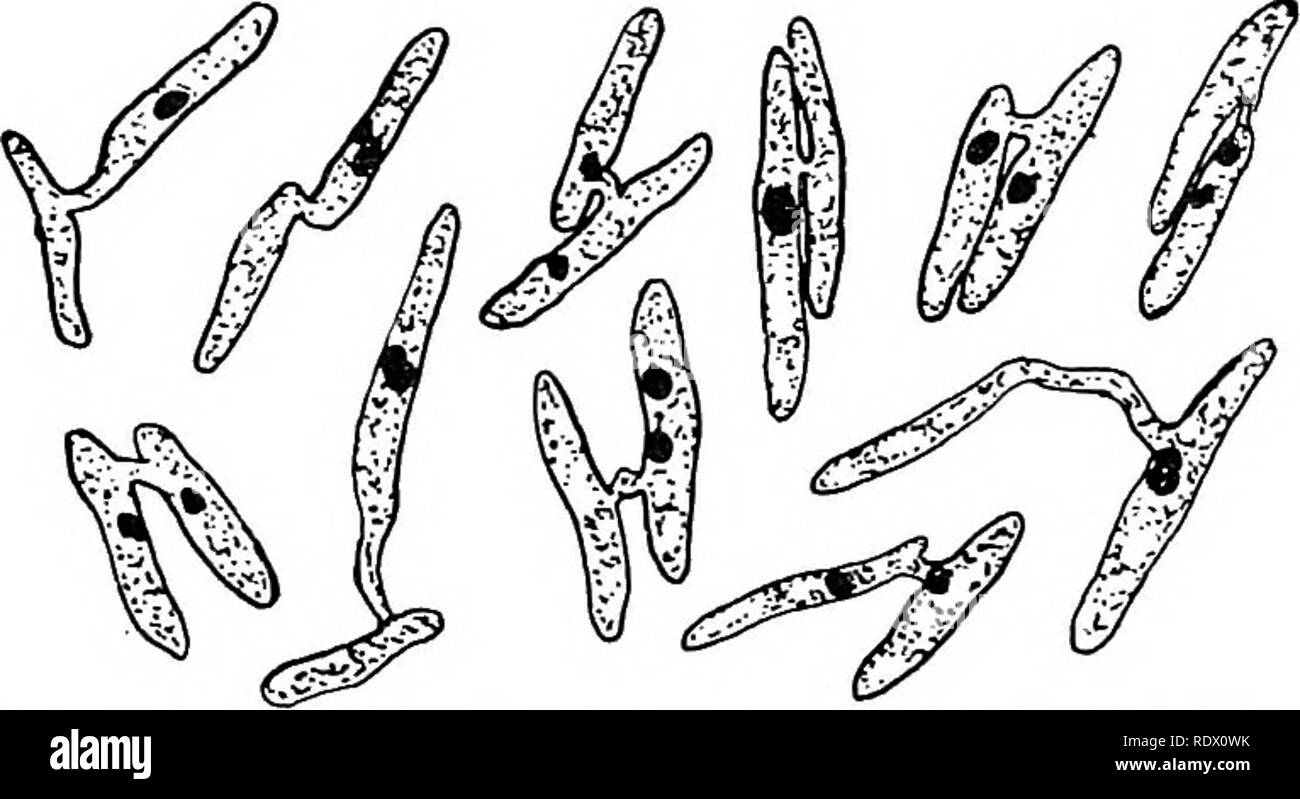 . Fungi, ascomycetes, ustilaginales, uredinales. Fungi. igo HEMIBASIDIOMYCETES [CH.. Federley, in 1903, described specimens of this fungus in which conjugation is followed not only by the migration of the nucleus of one of the cells concerned, but also by nuclear fusion (fig. 15s). In view of the fusion in the young spore recorded by Dangeard and by Rawitscher the details of de- velopment in this species de- mand further investigation. Ustilago Maydis, the smut of Zea Mays, induces con- siderable hypertrophy. The deformations contain a mass of gelatinous mycelium from which brand-spores are pr Stock Photohttps://www.alamy.com/image-license-details/?v=1https://www.alamy.com/fungi-ascomycetes-ustilaginales-uredinales-fungi-igo-hemibasidiomycetes-ch-federley-in-1903-described-specimens-of-this-fungus-in-which-conjugation-is-followed-not-only-by-the-migration-of-the-nucleus-of-one-of-the-cells-concerned-but-also-by-nuclear-fusion-fig-15s-in-view-of-the-fusion-in-the-young-spore-recorded-by-dangeard-and-by-rawitscher-the-details-of-de-velopment-in-this-species-de-mand-further-investigation-ustilago-maydis-the-smut-of-zea-mays-induces-con-siderable-hypertrophy-the-deformations-contain-a-mass-of-gelatinous-mycelium-from-which-brand-spores-are-pr-image232296783.html
. Fungi, ascomycetes, ustilaginales, uredinales. Fungi. igo HEMIBASIDIOMYCETES [CH.. Federley, in 1903, described specimens of this fungus in which conjugation is followed not only by the migration of the nucleus of one of the cells concerned, but also by nuclear fusion (fig. 15s). In view of the fusion in the young spore recorded by Dangeard and by Rawitscher the details of de- velopment in this species de- mand further investigation. Ustilago Maydis, the smut of Zea Mays, induces con- siderable hypertrophy. The deformations contain a mass of gelatinous mycelium from which brand-spores are pr Stock Photohttps://www.alamy.com/image-license-details/?v=1https://www.alamy.com/fungi-ascomycetes-ustilaginales-uredinales-fungi-igo-hemibasidiomycetes-ch-federley-in-1903-described-specimens-of-this-fungus-in-which-conjugation-is-followed-not-only-by-the-migration-of-the-nucleus-of-one-of-the-cells-concerned-but-also-by-nuclear-fusion-fig-15s-in-view-of-the-fusion-in-the-young-spore-recorded-by-dangeard-and-by-rawitscher-the-details-of-de-velopment-in-this-species-de-mand-further-investigation-ustilago-maydis-the-smut-of-zea-mays-induces-con-siderable-hypertrophy-the-deformations-contain-a-mass-of-gelatinous-mycelium-from-which-brand-spores-are-pr-image232296783.htmlRMRDX0WK–. Fungi, ascomycetes, ustilaginales, uredinales. Fungi. igo HEMIBASIDIOMYCETES [CH.. Federley, in 1903, described specimens of this fungus in which conjugation is followed not only by the migration of the nucleus of one of the cells concerned, but also by nuclear fusion (fig. 15s). In view of the fusion in the young spore recorded by Dangeard and by Rawitscher the details of de- velopment in this species de- mand further investigation. Ustilago Maydis, the smut of Zea Mays, induces con- siderable hypertrophy. The deformations contain a mass of gelatinous mycelium from which brand-spores are pr
 . Fungi, ascomycetes, ustilaginales, uredinales. Fungi. 128 DISCOMYCETES [CH. Rhizinaceae The Rhizinaceae are characterized by their unstalked fructification, and include the genera Rhizina and Sphaerosoma. Rhizina has a flattened, crust-Hke ascophore, more or less concave below, and attached to the soil by root-like strands of mycelium. The asci cover the upper surface. Rhizina inflata occurs in this country only as a saprophyte, growing on soil, but in both France and Germany it has been found to attack conifers. The disease, known as ring' disease, or root fungus, extends from a centre, inf Stock Photohttps://www.alamy.com/image-license-details/?v=1https://www.alamy.com/fungi-ascomycetes-ustilaginales-uredinales-fungi-128-discomycetes-ch-rhizinaceae-the-rhizinaceae-are-characterized-by-their-unstalked-fructification-and-include-the-genera-rhizina-and-sphaerosoma-rhizina-has-a-flattened-crust-hke-ascophore-more-or-less-concave-below-and-attached-to-the-soil-by-root-like-strands-of-mycelium-the-asci-cover-the-upper-surface-rhizina-inflata-occurs-in-this-country-only-as-a-saprophyte-growing-on-soil-but-in-both-france-and-germany-it-has-been-found-to-attack-conifers-the-disease-known-as-ring-disease-or-root-fungus-extends-from-a-centre-inf-image232269203.html
. Fungi, ascomycetes, ustilaginales, uredinales. Fungi. 128 DISCOMYCETES [CH. Rhizinaceae The Rhizinaceae are characterized by their unstalked fructification, and include the genera Rhizina and Sphaerosoma. Rhizina has a flattened, crust-Hke ascophore, more or less concave below, and attached to the soil by root-like strands of mycelium. The asci cover the upper surface. Rhizina inflata occurs in this country only as a saprophyte, growing on soil, but in both France and Germany it has been found to attack conifers. The disease, known as ring' disease, or root fungus, extends from a centre, inf Stock Photohttps://www.alamy.com/image-license-details/?v=1https://www.alamy.com/fungi-ascomycetes-ustilaginales-uredinales-fungi-128-discomycetes-ch-rhizinaceae-the-rhizinaceae-are-characterized-by-their-unstalked-fructification-and-include-the-genera-rhizina-and-sphaerosoma-rhizina-has-a-flattened-crust-hke-ascophore-more-or-less-concave-below-and-attached-to-the-soil-by-root-like-strands-of-mycelium-the-asci-cover-the-upper-surface-rhizina-inflata-occurs-in-this-country-only-as-a-saprophyte-growing-on-soil-but-in-both-france-and-germany-it-has-been-found-to-attack-conifers-the-disease-known-as-ring-disease-or-root-fungus-extends-from-a-centre-inf-image232269203.htmlRMRDTNMK–. Fungi, ascomycetes, ustilaginales, uredinales. Fungi. 128 DISCOMYCETES [CH. Rhizinaceae The Rhizinaceae are characterized by their unstalked fructification, and include the genera Rhizina and Sphaerosoma. Rhizina has a flattened, crust-Hke ascophore, more or less concave below, and attached to the soil by root-like strands of mycelium. The asci cover the upper surface. Rhizina inflata occurs in this country only as a saprophyte, growing on soil, but in both France and Germany it has been found to attack conifers. The disease, known as ring' disease, or root fungus, extends from a centre, inf
 . Fungous diseases of plants : with chapters on physiology, culture methods and technique . Fungi in agriculture. ASCOMYCETES 275 adheres closely to the underlying wood. Moreover, toe develop- ment of a callus layer at the edge of the dead spot gives a further emphasis to the depression produced by the death and shrinking of the tissues within t-he canker spots. The canker spots are sup- posed to persist for at least two years. The mycelium of the fun- gus may be found in the inner bark and cambium. As previously suggested, the pustules of the fungus break through the bark in these cankered sp Stock Photohttps://www.alamy.com/image-license-details/?v=1https://www.alamy.com/fungous-diseases-of-plants-with-chapters-on-physiology-culture-methods-and-technique-fungi-in-agriculture-ascomycetes-275-adheres-closely-to-the-underlying-wood-moreover-toe-develop-ment-of-a-callus-layer-at-the-edge-of-the-dead-spot-gives-a-further-emphasis-to-the-depression-produced-by-the-death-and-shrinking-of-the-tissues-within-t-he-canker-spots-the-canker-spots-are-sup-posed-to-persist-for-at-least-two-years-the-mycelium-of-the-fun-gus-may-be-found-in-the-inner-bark-and-cambium-as-previously-suggested-the-pustules-of-the-fungus-break-through-the-bark-in-these-cankered-sp-image232132306.html
. Fungous diseases of plants : with chapters on physiology, culture methods and technique . Fungi in agriculture. ASCOMYCETES 275 adheres closely to the underlying wood. Moreover, toe develop- ment of a callus layer at the edge of the dead spot gives a further emphasis to the depression produced by the death and shrinking of the tissues within t-he canker spots. The canker spots are sup- posed to persist for at least two years. The mycelium of the fun- gus may be found in the inner bark and cambium. As previously suggested, the pustules of the fungus break through the bark in these cankered sp Stock Photohttps://www.alamy.com/image-license-details/?v=1https://www.alamy.com/fungous-diseases-of-plants-with-chapters-on-physiology-culture-methods-and-technique-fungi-in-agriculture-ascomycetes-275-adheres-closely-to-the-underlying-wood-moreover-toe-develop-ment-of-a-callus-layer-at-the-edge-of-the-dead-spot-gives-a-further-emphasis-to-the-depression-produced-by-the-death-and-shrinking-of-the-tissues-within-t-he-canker-spots-the-canker-spots-are-sup-posed-to-persist-for-at-least-two-years-the-mycelium-of-the-fun-gus-may-be-found-in-the-inner-bark-and-cambium-as-previously-suggested-the-pustules-of-the-fungus-break-through-the-bark-in-these-cankered-sp-image232132306.htmlRMRDJF3E–. Fungous diseases of plants : with chapters on physiology, culture methods and technique . Fungi in agriculture. ASCOMYCETES 275 adheres closely to the underlying wood. Moreover, toe develop- ment of a callus layer at the edge of the dead spot gives a further emphasis to the depression produced by the death and shrinking of the tissues within t-he canker spots. The canker spots are sup- posed to persist for at least two years. The mycelium of the fun- gus may be found in the inner bark and cambium. As previously suggested, the pustules of the fungus break through the bark in these cankered sp
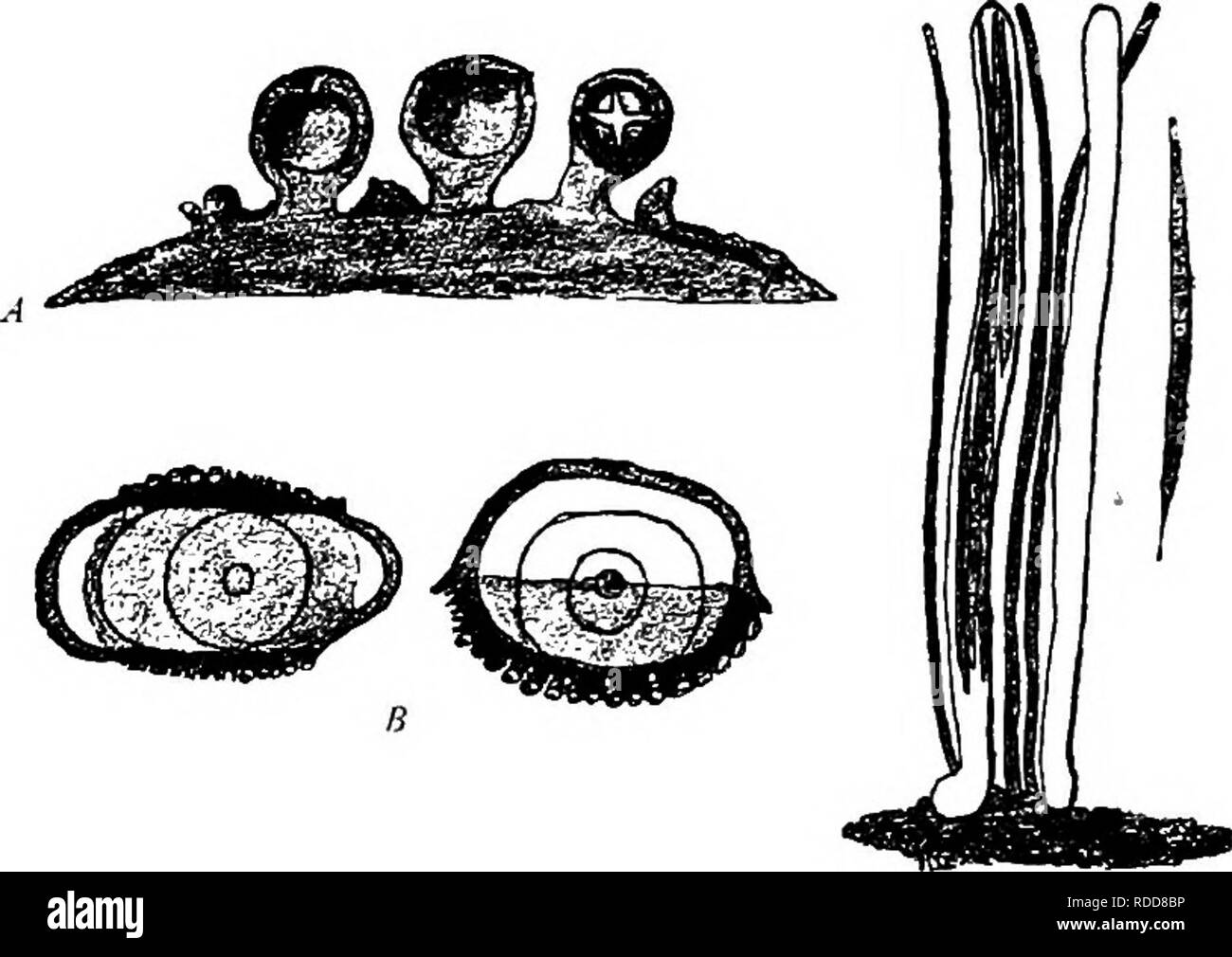 . Diseases of plants induced by cryptogamic parasites : introduction to the study of pathogenic Fungi, slime-Fungi, bacteria, & Algae . Plant diseases; Parasitic plants; Fungi. 250 ASCOMYCETES. Scleroderris. A ^black stroma is formed in the bark of twigs attacked by this fungus, and thence the apothecia break out in great numbers, at first as closed spheres, later as stalked open cups with finely lobed rims. The asci are cylindrical or club- m Fig. 13B-'Scleroderris full' rtinosa on living twig of Salix Caprea. (v. Tubeuf del.). Fig. 134.— i^clerodei-^'is faliginosa ou living twig of Salix Stock Photohttps://www.alamy.com/image-license-details/?v=1https://www.alamy.com/diseases-of-plants-induced-by-cryptogamic-parasites-introduction-to-the-study-of-pathogenic-fungi-slime-fungi-bacteria-amp-algae-plant-diseases-parasitic-plants-fungi-250-ascomycetes-scleroderris-a-black-stroma-is-formed-in-the-bark-of-twigs-attacked-by-this-fungus-and-thence-the-apothecia-break-out-in-great-numbers-at-first-as-closed-spheres-later-as-stalked-open-cups-with-finely-lobed-rims-the-asci-are-cylindrical-or-club-m-fig-13b-scleroderris-full-rtinosa-on-living-twig-of-salix-caprea-v-tubeuf-del-fig-134-iclerodei-is-faliginosa-ou-living-twig-of-salix-image232017290.html
. Diseases of plants induced by cryptogamic parasites : introduction to the study of pathogenic Fungi, slime-Fungi, bacteria, & Algae . Plant diseases; Parasitic plants; Fungi. 250 ASCOMYCETES. Scleroderris. A ^black stroma is formed in the bark of twigs attacked by this fungus, and thence the apothecia break out in great numbers, at first as closed spheres, later as stalked open cups with finely lobed rims. The asci are cylindrical or club- m Fig. 13B-'Scleroderris full' rtinosa on living twig of Salix Caprea. (v. Tubeuf del.). Fig. 134.— i^clerodei-^'is faliginosa ou living twig of Salix Stock Photohttps://www.alamy.com/image-license-details/?v=1https://www.alamy.com/diseases-of-plants-induced-by-cryptogamic-parasites-introduction-to-the-study-of-pathogenic-fungi-slime-fungi-bacteria-amp-algae-plant-diseases-parasitic-plants-fungi-250-ascomycetes-scleroderris-a-black-stroma-is-formed-in-the-bark-of-twigs-attacked-by-this-fungus-and-thence-the-apothecia-break-out-in-great-numbers-at-first-as-closed-spheres-later-as-stalked-open-cups-with-finely-lobed-rims-the-asci-are-cylindrical-or-club-m-fig-13b-scleroderris-full-rtinosa-on-living-twig-of-salix-caprea-v-tubeuf-del-fig-134-iclerodei-is-faliginosa-ou-living-twig-of-salix-image232017290.htmlRMRDD8BP–. Diseases of plants induced by cryptogamic parasites : introduction to the study of pathogenic Fungi, slime-Fungi, bacteria, & Algae . Plant diseases; Parasitic plants; Fungi. 250 ASCOMYCETES. Scleroderris. A ^black stroma is formed in the bark of twigs attacked by this fungus, and thence the apothecia break out in great numbers, at first as closed spheres, later as stalked open cups with finely lobed rims. The asci are cylindrical or club- m Fig. 13B-'Scleroderris full' rtinosa on living twig of Salix Caprea. (v. Tubeuf del.). Fig. 134.— i^clerodei-^'is faliginosa ou living twig of Salix
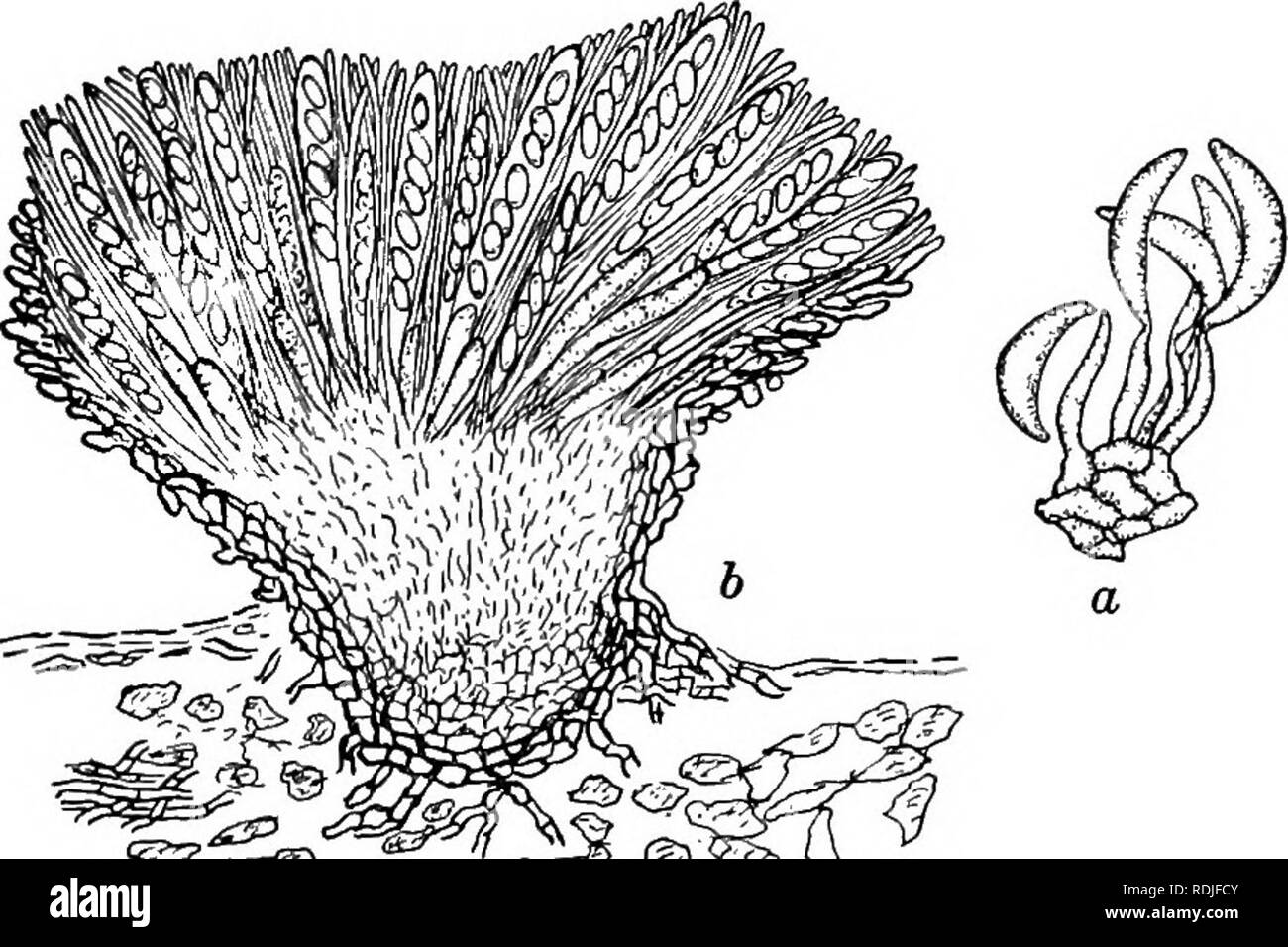 . Fungous diseases of plants : with chapters on physiology, culture methods and technique . Fungi in agriculture. ASCOMYCETES 207 shown in Fig. 80, b. The asci are club-shaped and bear eight hyaline ovoidal spores. The paraphyses are simple or branched, sometimes once-septate and slightly club-shaped. This fungus shows in pure culture certain growth characteristics which seem to differentiate it somewhat sharply from other species of Glceosporium. In the first place it grows slowly upon nutrient agar, several months being required to produce a colony of several millimeters in extent. The hypha Stock Photohttps://www.alamy.com/image-license-details/?v=1https://www.alamy.com/fungous-diseases-of-plants-with-chapters-on-physiology-culture-methods-and-technique-fungi-in-agriculture-ascomycetes-207-shown-in-fig-80-b-the-asci-are-club-shaped-and-bear-eight-hyaline-ovoidal-spores-the-paraphyses-are-simple-or-branched-sometimes-once-septate-and-slightly-club-shaped-this-fungus-shows-in-pure-culture-certain-growth-characteristics-which-seem-to-differentiate-it-somewhat-sharply-from-other-species-of-glceosporium-in-the-first-place-it-grows-slowly-upon-nutrient-agar-several-months-being-required-to-produce-a-colony-of-several-millimeters-in-extent-the-hypha-image232132571.html
. Fungous diseases of plants : with chapters on physiology, culture methods and technique . Fungi in agriculture. ASCOMYCETES 207 shown in Fig. 80, b. The asci are club-shaped and bear eight hyaline ovoidal spores. The paraphyses are simple or branched, sometimes once-septate and slightly club-shaped. This fungus shows in pure culture certain growth characteristics which seem to differentiate it somewhat sharply from other species of Glceosporium. In the first place it grows slowly upon nutrient agar, several months being required to produce a colony of several millimeters in extent. The hypha Stock Photohttps://www.alamy.com/image-license-details/?v=1https://www.alamy.com/fungous-diseases-of-plants-with-chapters-on-physiology-culture-methods-and-technique-fungi-in-agriculture-ascomycetes-207-shown-in-fig-80-b-the-asci-are-club-shaped-and-bear-eight-hyaline-ovoidal-spores-the-paraphyses-are-simple-or-branched-sometimes-once-septate-and-slightly-club-shaped-this-fungus-shows-in-pure-culture-certain-growth-characteristics-which-seem-to-differentiate-it-somewhat-sharply-from-other-species-of-glceosporium-in-the-first-place-it-grows-slowly-upon-nutrient-agar-several-months-being-required-to-produce-a-colony-of-several-millimeters-in-extent-the-hypha-image232132571.htmlRMRDJFCY–. Fungous diseases of plants : with chapters on physiology, culture methods and technique . Fungi in agriculture. ASCOMYCETES 207 shown in Fig. 80, b. The asci are club-shaped and bear eight hyaline ovoidal spores. The paraphyses are simple or branched, sometimes once-septate and slightly club-shaped. This fungus shows in pure culture certain growth characteristics which seem to differentiate it somewhat sharply from other species of Glceosporium. In the first place it grows slowly upon nutrient agar, several months being required to produce a colony of several millimeters in extent. The hypha
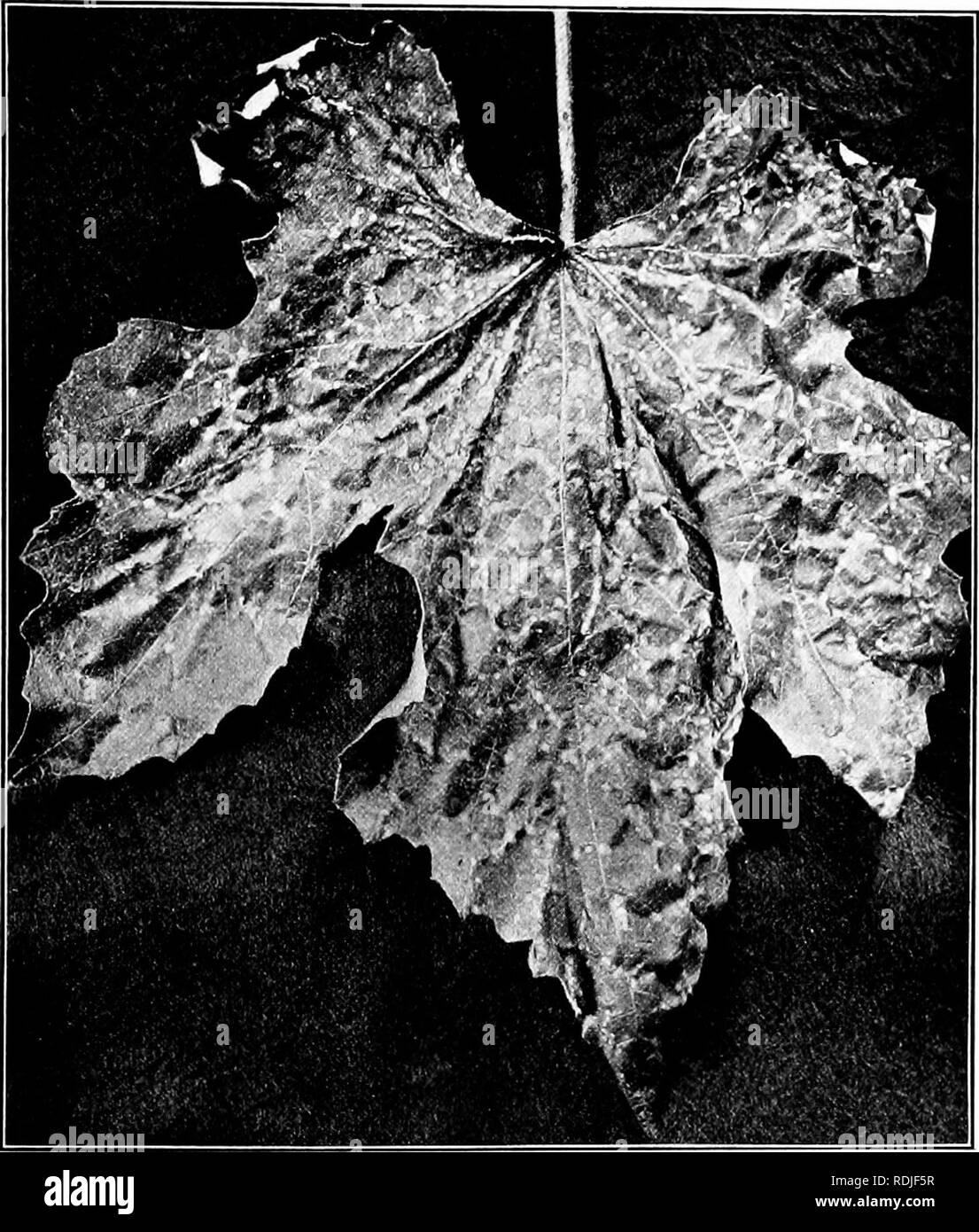 . Fungous diseases of plants : with chapters on physiology, culture methods and technique . Fungi in agriculture. ASCOMYCETES 257 mass of mycelium which arises beneath the epidermis. It is broadly elliptical, with a rather thick wall and no indication of a beak (Fig. 112, a). The conidiophores are short and simple, bear- ing spores — ovate or elliptical — measuring ordinarily 8-10 x 7- Sfi. In moist weather the spores are pushed out in vermiform. Fig. iii. Phyllosticta Stage of the Black Rot Fungus (Photograph by H. H. Whetzel) masses and upon dissemination they are capable of immediate germin Stock Photohttps://www.alamy.com/image-license-details/?v=1https://www.alamy.com/fungous-diseases-of-plants-with-chapters-on-physiology-culture-methods-and-technique-fungi-in-agriculture-ascomycetes-257-mass-of-mycelium-which-arises-beneath-the-epidermis-it-is-broadly-elliptical-with-a-rather-thick-wall-and-no-indication-of-a-beak-fig-112-a-the-conidiophores-are-short-and-simple-bear-ing-spores-ovate-or-elliptical-measuring-ordinarily-8-10-x-7-sfi-in-moist-weather-the-spores-are-pushed-out-in-vermiform-fig-iii-phyllosticta-stage-of-the-black-rot-fungus-photograph-by-h-h-whetzel-masses-and-upon-dissemination-they-are-capable-of-immediate-germin-image232132371.html
. Fungous diseases of plants : with chapters on physiology, culture methods and technique . Fungi in agriculture. ASCOMYCETES 257 mass of mycelium which arises beneath the epidermis. It is broadly elliptical, with a rather thick wall and no indication of a beak (Fig. 112, a). The conidiophores are short and simple, bear- ing spores — ovate or elliptical — measuring ordinarily 8-10 x 7- Sfi. In moist weather the spores are pushed out in vermiform. Fig. iii. Phyllosticta Stage of the Black Rot Fungus (Photograph by H. H. Whetzel) masses and upon dissemination they are capable of immediate germin Stock Photohttps://www.alamy.com/image-license-details/?v=1https://www.alamy.com/fungous-diseases-of-plants-with-chapters-on-physiology-culture-methods-and-technique-fungi-in-agriculture-ascomycetes-257-mass-of-mycelium-which-arises-beneath-the-epidermis-it-is-broadly-elliptical-with-a-rather-thick-wall-and-no-indication-of-a-beak-fig-112-a-the-conidiophores-are-short-and-simple-bear-ing-spores-ovate-or-elliptical-measuring-ordinarily-8-10-x-7-sfi-in-moist-weather-the-spores-are-pushed-out-in-vermiform-fig-iii-phyllosticta-stage-of-the-black-rot-fungus-photograph-by-h-h-whetzel-masses-and-upon-dissemination-they-are-capable-of-immediate-germin-image232132371.htmlRMRDJF5R–. Fungous diseases of plants : with chapters on physiology, culture methods and technique . Fungi in agriculture. ASCOMYCETES 257 mass of mycelium which arises beneath the epidermis. It is broadly elliptical, with a rather thick wall and no indication of a beak (Fig. 112, a). The conidiophores are short and simple, bear- ing spores — ovate or elliptical — measuring ordinarily 8-10 x 7- Sfi. In moist weather the spores are pushed out in vermiform. Fig. iii. Phyllosticta Stage of the Black Rot Fungus (Photograph by H. H. Whetzel) masses and upon dissemination they are capable of immediate germin